Polyvinyl Alcohol-Based Membranes: A Review of Research Progress on Design and Predictive Modeling of Properties for Targeted Application
Abstract
1. Introduction
2. Thermodynamic Modeling of Polymer Solutions: Polymer System Prediction and Membrane Performance Modeling
3. Methods for Manufacturing PVA-Based Membranes
3.1. Crosslinking
3.2. Interfacial Polymerization
3.3. Grafting
3.4. Blending with Other Polymers
3.5. Phase Inversion Method
- Immersion Precipitation (Non-Solvent Induced Phase Separation—NIPS): NIPS is the most widely employed technique, pioneered by Loeb and Sourirajan, initially for seawater desalination [105]. Originally developed for seawater desalination, it enabled the fabrication of the first cellulose acetate membrane and remains one of the most established and extensively used approaches for polymeric membrane synthesis. This method involves immersing a polymer solution in a non-solvent bath, leading to rapid phase separation and the formation of asymmetric membranes with distinct pore structures.
- 2.
- Evaporation-Induced Phase Separation (EIPS): EIPs is commonly used for PVA-based membranes, where solvent evaporation drives phase separation. Solvent selection, temperature, humidity, and volatility influence the membrane’s morphology. Typically, water or water–alcohol mixtures are employed to produce dense, defect-free membranes, suitable for applications like pervaporation and gas separation. However, due to PVA’s water solubility, chemical crosslinking (e.g., glutaraldehyde or boric acid) or thermal treatment is required for stability [109].
- 3.
- Vapor-Induced Phase Separation (VIPS): First introduced by Zsigmondy and Bachmann [110] and later advanced by Elford [111], this technique involves exposing the polymer solution to a vapor environment, leading to solvent diffusion into the vapor phase while non-solvent diffuses into the polymer. Plasticizers or crosslinkers (e.g., boric acid) enhance membrane flexibility and stability, making this method suitable for water filtration, biosensors, and drug delivery [21,112,113,114].
- 4.
- Thermally Induced Phase Separation (TIPS): TIPS involves cooling a polymer solution, causing the polymer to precipitate as its solubility decreases. PVA membranes produced by this method exhibit porous structures with controlled pore sizes, essential for selective filtration and high permeability applications. Common solvents include water and dimethyl sulfoxide (DMSO), with added non-solvents to regulate phase separation.
3.6. Dip-Coating
3.7. Electrospinning
4. Environmental Applications of PVA-Based Membranes
4.1. PVA-Based Membranes for Fuel Cell
4.2. PVA-Based Membranes for Water Treatment
4.2.1. PVA-Based Microfiltration Membranes (MF)
4.2.2. PVA-Based Membranes for Nanofiltration Process (NF)
4.2.3. PVA-Based Membranes for Ultrafiltration Process (UF)
4.2.4. PVA-Based Membranes for Reverse Osmosis (RO) Process
4.3. PVA-Based Membranes Used in Air Purification
5. Sustainable and Environmentally Friendly PVA-Based Food Packaging Material
6. Biomedical Applications of PVA-Based Membranes
6.1. Drug Delivery Systems
6.2. Wound Dressings
6.3. Tissue Engineering and Regenerative Medicine
6.4. Hemodialysis and Artificial Organs
6.5. Other Uses of PVA Membranes in the Biomedical Field
7. Conclusions and Future Perspectives
Author Contributions
Funding
Institutional Review Board Statement
Data Availability Statement
Conflicts of Interest
References
- Luis, P. Chapter 1—Introduction. In Fundamental Modelling of Membrane Systems; Luis, P., Ed.; Elsevier: Amsterdam, The Netherlands, 2018; pp. 1–23. [Google Scholar]
- Hahn-Hägerdal, B.; Galbe, M.; Gorwa-Grauslund, M.F.; Lidén, G.; Zacchi, G. Bio-ethanol—The fuel of tomorrow from the residues of today. Trends Biotechnol. 2006, 24, 549–556. [Google Scholar] [CrossRef] [PubMed]
- Farrell, A.E.; Plevin, R.J.; Turner, B.T.; Jones, A.D.; O’Hare, M.; Kammen, D.M. Ethanol Can Contribute to Energy and Environmental Goals. Science 2006, 311, 506–508. [Google Scholar] [CrossRef] [PubMed]
- Dautzenberg, F.M.; Mukherjee, M. Process intensification using multifunctional reactors. Chem. Eng. Sci. 2001, 56, 251–267. [Google Scholar] [CrossRef]
- Fried, J.R. Basic Principles of Membrane Technology By Marcel Mulder (University of Twente, The Netherlands). Kluwer Academic: Dordrecht. 1996. 564 pp. $255.00. ISBN 0-7823-4247-X. J. Am. Chem. Soc. 1997, 119, 8582. [Google Scholar] [CrossRef]
- Saleh, T.A.; Gupta, V.K. Chapter 1—An Overview of Membrane Science and Technology. In Nanomaterial and Polymer Membranes; Saleh, T.A., Gupta, V.K., Eds.; Elsevier: Amsterdam, The Netherlands, 2016; pp. 1–23. [Google Scholar]
- Ding, C.; Qiao, Z. A review of the application of polyvinyl alcohol membranes for fuel cells. Ionics 2022, 28, 1–13. [Google Scholar] [CrossRef]
- Choudhury, R.R.; Gohil, J.M.; Dutta, K. Poly(vinyl alcohol)-based membranes for fuel cell and water treatment applications: A review on recent advancements. Polym. Adv. Technol. 2021, 32, 4175–4203. [Google Scholar] [CrossRef]
- Lee, A.; Elam, J.W.; Darling, S.B. Membrane materials for water purification: Design, development, and application. Environ. Sci. Water Res. Technol. 2016, 2, 17–42. [Google Scholar] [CrossRef]
- Chen, X.; Li, J. Bioinspired by cell membranes: Functional polymeric materials for biomedical applications. Mater. Chem. Front. 2020, 4, 750–774. [Google Scholar] [CrossRef]
- Gupta, K.K.; Rehman, A.; Sarviya, R.M. Bio-fuels for the gas turbine: A review. Renew. Sustain. Energy Rev. 2010, 14, 2946–2955. [Google Scholar] [CrossRef]
- Baeyens, J.; Kang, Q.; Appels, L.; Dewil, R.; Lv, Y.; Tan, T. Challenges and opportunities in improving the production of bio-ethanol. Prog. Energy Combust. Sci. 2015, 47, 60–88. [Google Scholar] [CrossRef]
- Guo, Q.; Huang, Y.; Xu, M.; Huang, Q.; Cheng, J.; Yu, S.; Zhang, Y.; Xiao, C. PTFE porous membrane technology: A comprehensive review. J. Membr. Sci. 2022, 664, 121115. [Google Scholar] [CrossRef]
- Liu, G.; Jin, W.; Xu, N. Two-Dimensional-Material Membranes: A New Family of High-Performance Separation Membranes. Angew. Chem. Int. Ed. 2016, 55, 13384–13397. [Google Scholar] [CrossRef] [PubMed]
- Zuo, K.; Wang, K.; DuChanois, R.M.; Fang, Q.; Deemer, E.M.; Huang, X.; Xin, R.; Said, I.A.; He, Z.; Feng, Y.; et al. Selective membranes in water and wastewater treatment: Role of advanced materials. Mater. Today 2021, 50, 516–532. [Google Scholar] [CrossRef]
- Chen, N.; Lee, Y.M. Anion exchange polyelectrolytes for membranes and ionomers. Prog. Polym. Sci. 2021, 113, 101345. [Google Scholar] [CrossRef]
- Kang, N.R.; Pham, T.H.; Nederstedt, H.; Jannasch, P. Durable and highly proton conducting poly(arylene perfluorophenylphosphonic acid) membranes. J. Membr. Sci. 2021, 623, 119074. [Google Scholar] [CrossRef]
- Kang, G.-d.; Cao, Y.-m. Application and modification of poly(vinylidene fluoride) (PVDF) membranes—A review. J. Membr. Sci. 2014, 463, 145–165. [Google Scholar] [CrossRef]
- Dutta, K.; Das, S.; Kundu, P.P. Effect of the presence of partially sulfonated polyaniline on the proton and methanol transport behavior of partially sulfonated PVdF membrane. Polym. J. 2016, 48, 301–309. [Google Scholar] [CrossRef]
- Dutta, K.; Das, S.; Kundu, P.P. Highly methanol resistant and selective ternary blend membrane composed of sulfonated PVdF-co-HFP, sulfonated polyaniline and nafion. J. Appl. Polym. Sci. 2016, 133, 43294. [Google Scholar] [CrossRef]
- Chousidis, N. Polyvinyl alcohol (PVA)-based films: Insights from crosslinking and plasticizer incorporation. Eng. Res. Express 2024, 6, 025010. [Google Scholar] [CrossRef]
- Wen, Y.; Yuan, J.; Ma, X.; Wang, S.; Liu, Y. Polymeric nanocomposite membranes for water treatment: A review. Environ. Chem. Lett. 2019, 17, 1539–1551. [Google Scholar] [CrossRef]
- Marcos-Madrazo, A.; Casado-Coterillo, C.; García-Cruz, L.; Iniesta, J.; Simonelli, L.; Sebastián, V.; Encabo-Berzosa, M.D.M.; Arruebo, M.; Irabien, Á. Preparation and Identification of Optimal Synthesis Conditions for a Novel Alkaline Anion-Exchange Membrane. Polymers 2018, 10, 913. [Google Scholar] [CrossRef] [PubMed]
- Ahmadi, M.; Janakiram, S.; Dai, Z.; Ansaloni, L.; Deng, L. Performance of Mixed Matrix Membranes Containing Porous Two-Dimensional (2D) and Three-Dimensional (3D) Fillers for CO2 Separation: A Review. Membranes 2018, 8, 50. [Google Scholar] [CrossRef] [PubMed]
- Kim, S.; Scholes, C.A.; Heath, D.E.; Kentish, S.E. Gas-liquid membrane contactors for carbon dioxide separation: A review. Chem. Eng. J. 2021, 411, 128468. [Google Scholar] [CrossRef]
- Wang, K.Y.; Weber, M.; Chung, T.-S. Polybenzimidazoles (PBIs) and state-of-the-art PBI hollow fiber membranes for water, organic solvent and gas separations: A review. J. Mater. Chem. A 2022, 10, 8687–8718. [Google Scholar] [CrossRef]
- Yang, G.; Xie, Z.; Doherty, C.M.; Cran, M.; Ng, D.; Gray, S. Understanding the transport enhancement of poly (vinyl alcohol) based hybrid membranes with dispersed nanochannels for pervaporation application. J. Membr. Sci. 2020, 603, 118005. [Google Scholar] [CrossRef]
- Torstensen, J.Ø.; Helberg, R.M.L.; Deng, L.; Gregersen, Ø.W.; Syverud, K. PVA/nanocellulose nanocomposite membranes for CO2 separation from flue gas. Int. J. Greenh. Gas Control 2019, 81, 93–102. [Google Scholar] [CrossRef]
- Higa, M.; Kakihana, Y.; Sugimoto, T.; Toyota, K. Preparation of PVA-Based Hollow Fiber Ion-Exchange Membranes and Their Performance for Donnan Dialysis. Membranes 2019, 9, 4. [Google Scholar] [CrossRef]
- Manohar, D.; Babu, R.S.; Vijaya, B.; Nallakumar, S.; Gobi, R.; Anand, S.; Nishanth, D.S.; Anupama, A.; Rani, M.U. A review on exploring the potential of PVA and chitosan in biomedical applications: A focus on tissue engineering, drug delivery and biomedical sensors. Int. J. Biol. Macromol. 2024, 283, 137318. [Google Scholar] [CrossRef]
- Khang, G. Handbook of Intelligent Scaffolds for Tissue Engineering and Regenerative Medicine, 2nd ed.; Jenny Stanford Publishing: Dubai, United Arab Emirates, 2017. [Google Scholar]
- Taylor, C.J.; Pomberger, A.; Felton, K.C.; Grainger, R.; Barecka, M.; Chamberlain, T.W.; Bourne, R.A.; Johnson, C.N.; Lapkin, A.A. A Brief Introduction to Chemical Reaction Optimization. Chem. Rev. 2023, 123, 3089–3126. [Google Scholar] [CrossRef]
- Bae, H.; Choi, M.; Chung, Y.-C.; Lee, S.; Yoo, Y.J. Core-shell structured poly(vinyl alcohol)/sodium alginate bead for single-stage autotrophic nitrogen removal. Chem. Eng. J. 2017, 322, 408–416. [Google Scholar] [CrossRef]
- Li, H.; Liu, Q.; Dong, H.; Duan, Y.; Zhou, Z.; Zhang, J. Porous solid carbon source-supported denitrification in simulated mariculture wastewater. Environ. Technol. 2021, 42, 1196–1203. [Google Scholar] [CrossRef] [PubMed]
- Xu, X.; Lv, C.; You, X.; Wang, B.; Ji, F.; Hu, B. Nitrogen removal and microbial diversity of activated sludge entrapped in modified poly(vinyl alcohol)–sodium alginate gel. Int. Biodeterior. Biodegrad. 2017, 125, 243–250. [Google Scholar] [CrossRef]
- Hayashi, T.; Kinashi, K.; Sakai, W.; Tsutsumi, N.; Fujii, A.; Inada, S.; Yamamoto, H. Spin-trapping analysis for thermal degradation of poly(vinyl alcohol). Polymer 2021, 217, 123416. [Google Scholar] [CrossRef]
- Selvi, J.; Mahalakshmi, S.; Parthasarathy, V.; Hu, C.; Lin, Y.-F.; Tung, K.-L.; Anbarasan, R.; Annie, A.A. Optical, thermal, mechanical properties, and non-isothermal degradation kinetic studies on PVA/CuO nanocomposites. Polym. Compos. 2019, 40, 3737–3748. [Google Scholar] [CrossRef]
- Chung, G.C.; Kornfield, J.A.; Smith, S.D. Compositional Dependence of Segmental Dynamics in a Miscible Polymer Blend. Macromolecules 1994, 27, 5729–5741. [Google Scholar] [CrossRef]
- Kawaguchi, M. Interfacial characteristics of binary polymer blend films spread at the air-water interface. Adv. Colloid Interface Sci. 2017, 247, 163–171. [Google Scholar] [CrossRef]
- Rafailovich, M.H.; Sokolov, J.; Jones, R.A.L.; Krausch, G.; Klein, J.; Mills, R. Interface Formation in a Partially Miscible Polymer Blend. Europhys. Lett. 1988, 5, 657–662. [Google Scholar] [CrossRef]
- Katsaros, J.D.; Malone, M.F.; Winter, H.H. Extensional flow induced miscibility in a polymer blend. Polym. Bull. 1986, 16, 83–88. [Google Scholar] [CrossRef]
- Higgins, J.S.; Lipson, J.E.G.; White, R.P. A simple approach to polymer mixture miscibility. Philos. Trans. R. Soc. A Math. Phys. Eng. Sci. 2010, 368, 1009–1025. [Google Scholar] [CrossRef]
- Janssen, S.; Schwahn, D.; Mortensen, K.; Springer, T. Pressure dependence of the Flory-Huggins interaction parameter in polymer blends: A SANS study and a comparison to the Flory-Orwoll-Vrij equation of state. Macromolecules 1993, 26, 5587–5591. [Google Scholar] [CrossRef]
- Robeson, L. Historical Perspective of Advances in the Science and Technology of Polymer Blends. Polymers 2014, 6, 1251–1265. [Google Scholar] [CrossRef]
- Schneier, B. Polymer compatibility. J. Appl. Polym. Sci. 1973, 17, 3175–3185. [Google Scholar] [CrossRef]
- Razmgar, K.; Saljoughi, E.; Mousavi, S.M. Preparation and characterization of a novel hydrophilic PVDF/PVA/Al2O3 nanocomposite membrane for removal of As(V) from aqueous solutions. Polym. Compos. 2019, 40, 2452–2461. [Google Scholar] [CrossRef]
- M’barki, O.; Hanafia, A.; Bouyer, D.; Faur, C.; Sescousse, R.; Delabre, U.; Blot, C.; Guenoun, P.; Deratani, A.; Quemener, D.; et al. Greener method to prepare porous polymer membranes by combining thermally induced phase separation and crosslinking of poly(vinyl alcohol) in water. J. Membr. Sci. 2014, 458, 225–235. [Google Scholar] [CrossRef]
- Bouyer, D.; M’Barki, O.; Pochat-Bohatier, C.; Faur, C.; Petit, E.; Guenoun, P. Modeling the membrane formation of novel PVA membranes for predicting the composition path and their final morphology. AIChE J. 2017, 63, 3035–3047. [Google Scholar] [CrossRef]
- Young, T.-H.; Chuang, W.-Y. Thermodynamic analysis on the cononsolvency of poly (vinyl alcohol) in water–DMSO mixtures through the ternary interaction parameter. J. Membr. Sci. 2002, 210, 349–359. [Google Scholar] [CrossRef]
- Reuvers, A.J.; van den Berg, J.W.A.; Smolders, C.A. Formation of membranes by means of immersion precipitation: Part I. A model to describe mass transfer during immersion precipitation. J. Membr. Sci. 1987, 34, 45–65. [Google Scholar] [CrossRef]
- Boom, R.M.; Boomgaard, T.v.D.; Smolders, C.A. Mass Transfer and Thermodynamics During Immersion Precipitation for a Two-Polymer System: Evaluation with the System PES-PVP-NMP-Water. J. Membr. Sci. 1994, 90, 231–249. [Google Scholar] [CrossRef]
- Aryanti, P.T.P.; Ariono, D.; Hakim, A.N.; Wenten, I.G. Flory-Huggins Based Model to Determine Thermodynamic Property of Polymeric Membrane Solution. J. Phys. Conf. Ser. 2018, 1090, 012074. [Google Scholar] [CrossRef]
- Chen, J.; Huang, J.; Li, J.-d.; Zhan, X.; Chen, C. A Modified Solution–Diffusion Model and Its Application in the Pervaporation Separation of Benzene/Cyclohexane Mixtures in PDMS Membrane. J. Chem. Eng. Jpn. 2009, 42, 640–647. [Google Scholar] [CrossRef]
- Ethier, J.G.; Audus, D.J.; Ryan, D.C.; Vaia, R.A. Integrating theory with machine learning for predicting polymer solution phase behavior. Giant 2023, 15, 100171. [Google Scholar] [CrossRef]
- Ren, J.; Chowdhury, M.R.; Xia, L.; Ma, C.; Bollas, G.M.; McCutcheon, J.R. A computational fluid dynamics model to predict performance of hollow fiber membrane modules in forward osmosis. J. Membr. Sci. 2020, 603, 117973. [Google Scholar] [CrossRef]
- Staszak, M. Modeling and simulation of membrane process. Phys. Sci. Rev. 2017, 2, 20170023. [Google Scholar] [CrossRef]
- Bird, R.B. Transport phenomena. Appl. Mech. Rev. 2002, 55, R1–R4. [Google Scholar] [CrossRef]
- Pabby, A.K.; Rizvi, S.S.H.; Requena, A.M.S. (Eds.) Handbook of Membrane Separations: Chemical, Pharmaceutical, Food, and Biotechnological Applications, 1st ed.; CRC Press: Boca Raton, FL, USA, 2008. [Google Scholar] [CrossRef]
- Tsuru, T.; Nakao, S.-I.; Kimura, S. Calculation of ion rejection by extended Nernst–Planck equation with charged reverse osmosis membranes for single and mixed electrolyte solutions. J. Chem. Eng. Jpn. 1991, 24, 511–517. [Google Scholar] [CrossRef]
- Bowen, W.R.; Mohammad, A.W.; Hilal, N. Characterisation of nanofiltration membranes for predictive purposes—Use of salts, uncharged solutes and atomic force microscopy. J. Membr. Sci. 1997, 126, 91–105. [Google Scholar] [CrossRef]
- Perry, M.; Linder, C. Intermediate reverse osmosis ultrafiltration (RO UF) membranes for concentration and desalting of low molecular weight organic solutes. Desalination 1989, 71, 233–245. [Google Scholar] [CrossRef]
- Xu, X.; Spencer, H.G. Dye-salt separations by nanofiltration using weak acid polyelectrolyte membranes. Desalination 1997, 114, 129–137. [Google Scholar] [CrossRef]
- Schirg, P.; Widmer, F. Characterisation of nanofiltration membranes for the separation of aqueous dye-salt solutions. Desalination 1992, 89, 89–107. [Google Scholar] [CrossRef]
- Levenstein, R.; Hasson, D.; Semiat, R. Utilization of the Donnan effect for improving electrolyte separation with nanofiltration membranes. J. Membr. Sci. 1996, 116, 77–92. [Google Scholar] [CrossRef]
- Geraldes, V.t.; Semião, V.; de Pinho, M.N. Flow and mass transfer modelling of nanofiltration. J. Membr. Sci. 2001, 191, 109–128. [Google Scholar] [CrossRef]
- Shaalan, H.F. Development of fouling control strategies pertinent to nanofiltration membranes. Desalination 2003, 153, 125–131. [Google Scholar] [CrossRef]
- Nath, K. Membrane Separation Processes; PHI Learning Pvt. Ltd.: Delhi, India, 2017. [Google Scholar]
- Sagle, A.; Freeman, B. Fundamentals of membranes for water treatment. Future Desalination Tex. 2004, 2, 137. [Google Scholar]
- Tan, X.; Rodrigue, D. A Review on Porous Polymeric Membrane Preparation. Part I: Production Techniques with Polysulfone and Poly (Vinylidene Fluoride). Polymers 2019, 11, 1160. [Google Scholar] [CrossRef]
- Wang, D.-M.; Lai, J.-Y. Recent advances in preparation and morphology control of polymeric membranes formed by nonsolvent induced phase separation. Curr. Opin. Chem. Eng. 2013, 2, 229–237. [Google Scholar] [CrossRef]
- Raota, C.S.; Crespo, J.D.; Baldasso, C.; Giovanela, M. Development of a Green Polymeric Membrane for Sodium Diclofenac Removal from Aqueous Solutions. Membranes 2023, 13, 662. [Google Scholar] [CrossRef]
- Dmitrenko, M.; Penkova, A.; Kuzminova, A.; Morshed, M.; Larionov, M.; Alem, H.; Zolotarev, A.; Ermakov, S.; Roizard, D. Investigation of new modification strategies for PVA membranes to improve their dehydration properties by pervaporation. Appl. Surf. Sci. 2018, 450, 527–537. [Google Scholar] [CrossRef]
- Bolto, B.; Tran, T.; Hoang, M.; Xie, Z. Crosslinked poly(vinyl alcohol) membranes. Prog. Polym. Sci. 2009, 34, 969–981. [Google Scholar] [CrossRef]
- Otsuka, E.; Suzuki, A. Swelling Properties of Physically Cross-linked PVA Gels Prepared by a Cast-drying Method. In Gels: Structures, Properties, and Functions; Springer: Berlin/Heidelberg, Germany, 2009; pp. 121–126. [Google Scholar]
- Amanda, A.; Mallapragada, S.K. Comparison of protein fouling on heat-treated poly(vinyl alcohol), poly(ether sulfone) and regenerated cellulose membranes using diffuse reflectance infrared Fourier transform spectroscopy. Biotechnol. Prog. 2001, 17, 917–923. [Google Scholar] [CrossRef]
- Nikolic, V.M.; Krkljes, A.; Popovic, Z.K.; Lausevic, Z.V.; Miljanic, S.S. On the use of gamma irradiation crosslinked PVA membranes in hydrogen fuel cells. Electrochem. Commun. 2007, 9, 2661–2665. [Google Scholar] [CrossRef]
- Maiti, J.; Kakati, N.; Lee, S.H.; Jee, S.H.; Viswanathan, B.; Yoon, Y.S. Where do poly(vinyl alcohol) based membranes stand in relation to Nafion® for direct methanol fuel cell applications? J. Power Sources 2012, 216, 48–66. [Google Scholar] [CrossRef]
- Wu, C.; Li, A.; Li, L.; Zhang, L.; Wang, H.; Qi, X.; Zhang, Q. Treatment of oily water by a poly(vinyl alcohol) ultrafiltration membrane. Desalination 2008, 225, 312–321. [Google Scholar] [CrossRef]
- Wang, Y.-L.; Yang, H.; Xu, Z.-L. Influence of post-treatments on the properties of porous poly(vinyl alcohol) membranes. J. Appl. Polym. Sci. 2008, 107, 1423–1429. [Google Scholar] [CrossRef]
- Wan, X.; Zhang, M.; Wang, Y.; Chen, B.; Gui, Z.; Xu, Y.; Zhang, Y.; Chen, D.; Du, Z.; Nathabeth Jah, T. Molecule structure design by synergistic crosslinking in the PVA matrix and its physical properties regulation. Colloids Surf. A Physicochem. Eng. Asp. 2024, 683, 133104. [Google Scholar] [CrossRef]
- Do Nascimento, F.C.; de Aguiar, L.C.V.; Costa, L.A.T.; Fernandes, M.T.; Marassi, R.J.; Gomes, A.d.S.; de Castro, J.A. Formulation and characterization of crosslinked polyvinyl alcohol (PVA) membranes: Effects of the crosslinking agents. Polym. Bull. 2021, 78, 917–929. [Google Scholar] [CrossRef]
- Adamczak, M.; Kamińska, G.; Bohdziewicz, J. Preparation of Polymer Membranes by In Situ Interfacial Polymerization. Int. J. Polym. Sci. 2019, 2019, 6217924. [Google Scholar] [CrossRef]
- Song, W.; Zeng, Q.; Yin, X.; Zhu, L.; Gong, T.; Pan, C. Preparation and anticoagulant properties of heparin-like electrospun membranes from carboxymethyl chitosan and bacterial cellulose sulfate. Int. J. Biol. Macromol. 2018, 120, 1396–1405. [Google Scholar] [CrossRef]
- Zhang, Q.; Li, Q.; Zhang, L.; Wang, S.; Harper, D.P.; Wu, Q.; Young, T.M. Preparation of electrospun nanofibrous poly(vinyl alcohol)/cellulose nanocrystals air filter for efficient particulate matter removal with repetitive usage capability via facile heat treatment. Chem. Eng. J. 2020, 399, 125768. [Google Scholar] [CrossRef]
- Song, Y.; Fan, J.-B.; Wang, S. Recent progress in interfacial polymerization. Mater. Chem. Front. 2017, 1, 1028–1040. [Google Scholar] [CrossRef]
- Li, L.-Q.; Tang, Y.-J.; Xu, Z.-L. Can the NF membrane directly obtained by the interfacial polymerization of MPD and TMC? J. Membr. Sci. 2022, 656, 120618. [Google Scholar] [CrossRef]
- Miao, J.; Zhang, R.; Bai, R. Poly (vinyl alcohol)/carboxymethyl cellulose sodium blend composite nanofiltration membranes developed via interfacial polymerization. J. Membr. Sci. 2015, 493, 654–663. [Google Scholar] [CrossRef]
- Xu, R.; Ding, L.; Chen, D.; Liu, T.; Wu, Y.; Cao, Y.; Chen, J.; Yang, F.; Kang, J.; Xiang, M. Enhancing the Chlorine Stability and Antifouling Properties of Thin-Film Composite Reverse Osmosis Membranes via Surface Grafting L-Arginine-Functionalized Polyvinyl Alcohol. Ind. Eng. Chem. Res. 2020, 59, 10882–10893. [Google Scholar] [CrossRef]
- Li, F.; Ye, J.; Yang, L.; Deng, C.; Tian, Q.; Yang, B. Surface modification of ultrafiltration membranes by grafting glycine-functionalized PVA based on polydopamine coatings. Appl. Surf. Sci. 2015, 345, 301–309. [Google Scholar] [CrossRef]
- Feipeng, d.; Wang, J.J.; Ye, E.Z.; Zhou, X.P. Microstructure and properties of PSA-g-MWNT reinforced PVA/PSA blend membrane. Gongneng Cailiao/J. Funct. Mater. 2012, 43, 642–644+649. [Google Scholar]
- Kim, D.H.; Park, M.S.; Choi, Y.; Lee, K.B.; Kim, J.H. Synthesis of PVA-g-POEM graft copolymers and their use in highly permeable thin film composite membranes. Chem. Eng. J. 2018, 346, 739–747. [Google Scholar] [CrossRef]
- Wang, M.; Cheng, X.; Jiang, G.; Xie, J.; Cai, W.; Li, J.; Wang, Y. Preparation and pervaporation performance of PVA membrane with biomimetic modified silica nanoparticles as coating. J. Membr. Sci. 2022, 653, 120535. [Google Scholar] [CrossRef]
- Adib, H.; Raisi, A. Surface modification of a PES membrane by corona air plasma-assisted grafting of HB-PEG for separation of oil-in-water emulsions. RSC Adv. 2020, 10, 17143–17153. [Google Scholar] [CrossRef]
- Yang, M.-C.; Lin, W.-C. The grafting of chitosan oligomer to polysulfone membrane via ozone-treatment and its effect on anti-bacterial activity. J. Polym. Res. 2002, 9, 135–140. [Google Scholar] [CrossRef]
- Bui, T.D.; Wong, Y.; Thu, K.; Oh, S.J.; Kum Ja, M.; Ng, K.C.; Raisul, I.; Chua, K.J. Effect of hygroscopic materials on water vapor permeation and dehumidification performance of poly(vinyl alcohol) membranes. J. Appl. Polym. Sci. 2017, 134, 44765. [Google Scholar] [CrossRef]
- Khongnakorn, W.; Bootluck, W.; Jutaporn, P. Surface modification of FO membrane by plasma-grafting polymerization to minimize protein fouling. J. Water Process Eng. 2020, 38, 101633. [Google Scholar] [CrossRef]
- Kim, M.; Kojima, J.; Saito, K.; Furusaki, S.; Sugo, T. Reduction of nonselective adsorption of proteins by hydrophilization of microfiltration membranes by radiation-induced grafting. Biotechnol. Prog. 1994, 10, 114–120. [Google Scholar] [CrossRef] [PubMed]
- Kozliak, E.I.; Paca, J. Foreword. J. Environ. Sci. Health Part A Toxic/Hazard. Subst. Environ. Eng. 2012, 47, 919. [Google Scholar] [CrossRef] [PubMed]
- Rabiee, N.; Sharma, R.; Foorginezhad, S.; Jouyandeh, M.; Asadnia, M.; Rabiee, M.; Akhavan, O.; Lima, E.C.; Formela, K.; Ashrafizadeh, M.; et al. Green and sustainable membranes: A review. Environ. Res. 2023, 231, 116133. [Google Scholar] [CrossRef]
- Cheng, X.; Cai, W.; Chen, X.; Shi, Z.; Li, J. Preparation of graphene oxide/poly(vinyl alcohol) composite membrane and pervaporation performance for ethanol dehydration. RSC Adv. 2019, 9, 15457–15465. [Google Scholar] [CrossRef]
- Chuang, W.Y.; Young, T.H.; Chiu, W.Y.; Lin, C.Y. The effect of polymeric additives on the structure and permeability of poly(vinyl alcohol) asymmetric membranes. Polymer 2000, 41, 5633–5641. [Google Scholar] [CrossRef]
- Wang, W.; Gong, Y.; Sun, Q.; Li, L.; Xu, A.; Liu, R. High performance polyvinyl alcohol/polylactic acid materials: Facile preparation and improved properties. J. Appl. Polym. Sci. 2022, 139, e52470. [Google Scholar] [CrossRef]
- Kesting, R.E. Phase Inversion Membranes; ACS Publications: Washington, DC, USA, 1985. [Google Scholar]
- Guillen, G.R.; Pan, Y.; Li, M.; Hoek, E.M.V. Preparation and Characterization of Membranes Formed by Nonsolvent Induced Phase Separation: A Review. Ind. Eng. Chem. Res. 2011, 50, 3798–3817. [Google Scholar] [CrossRef]
- Ying, L.; Yu, W.H.; Kang, E.T.; Neoh, K.G. Functional and Surface-Active Membranes from Poly(vinylidene fluoride)-graft-Poly(acrylic acid) Prepared via RAFT-Mediated Graft Copolymerization. Langmuir 2004, 20, 6032–6040. [Google Scholar] [CrossRef]
- Keshavarz, L.; Khansary, M.A.; Shirazian, S. Phase diagram of ternary polymeric solutions containing nonsolvent/solvent/polymer: Theoretical calculation and experimental validation. Polymer 2015, 73, 1–8. [Google Scholar] [CrossRef]
- Mulder, M. MEMBRANE PREPARATION|Phase Inversion Membranes. In Encyclopedia of Separation Science; Elsevier: Amsterdam, The Netherlands, 2000; pp. 3331–3346. [Google Scholar]
- Abuhatab, F.; Hasan, S.W. Green fabrication methods and performance evaluation of eco-friendly membranes for enhanced oil-water separation. J. Environ. Chem. Eng. 2024, 12, 113993. [Google Scholar] [CrossRef]
- Chaudhari, S.; Kwon, Y.; Shon, M.; Nam, S.; Park, Y. Stability and pervaporation characteristics of PVA and its blend with PVAm membranes in a ternary feed mixture containing highly reactive epichlorohydrin. RSC Adv. 2019, 9, 5908–5917. [Google Scholar] [CrossRef] [PubMed]
- Zsigmondy, R.; Bachmann, W. Über neue Filter. Z. Anorg. Allg. Chem. 1918, 103, 119–128. [Google Scholar] [CrossRef]
- Elford, W.J. Principles governing the preparation of membranes having graded porosities. The properties of “gradocol” membranes as ultrafilters. Trans. Faraday Soc. 1937, 33, 1094–1104. [Google Scholar] [CrossRef]
- De Lima, G.G.; Júnior, E.L.S.; Aggio, B.B.; Shee, B.S.; Filho, E.M.M.; Segundo, F.A.S.; Fournet, M.B.; Devine, D.M.; Magalhães, W.L.E.; de Sá, M.J.C. Nanocellulose for peripheral nerve regeneration in rabbits using citric acid as crosslinker with chitosan and freeze/thawed PVA. Biomed. Mater. 2021, 16, 055011. [Google Scholar] [CrossRef]
- Ben Halima, N. Poly(vinyl alcohol): Review of its promising applications and insights into biodegradation. RSC Adv. 2016, 6, 39823–39832. [Google Scholar] [CrossRef]
- Moulay, S. Poly (vinyl alcohol) functionalizations and applications. Polym.-Plast. Technol. Eng. 2015, 54, 1289–1319. [Google Scholar] [CrossRef]
- Chae, S.-K.; Mun, C.H.; Noh, D.-Y.; Kang, E.; Lee, S.-H. Simple Fabrication Method for a Porous Poly(vinyl alcohol) Matrix by Multisolvent Mixtures for an Air-Exposed Model of the Lung Epithelial System. Langmuir 2014, 30, 12107–12113. [Google Scholar] [CrossRef]
- Kim, S.-G.; Lee, K.-H. Poly(vinyl alcohol) Membranes Having an Integrally Skinned Asymmetric Structure. Mol. Cryst. Liq. Cryst. 2009, 512, 32/[1878]–39/[1885]. [Google Scholar] [CrossRef]
- Ahmad, A.L.; Yusuf, N.M.; Ooi, B.S. Preparation and modification of poly (vinyl) alcohol membrane: Effect of crosslinking time towards its morphology. Desalination 2012, 287, 35–40. [Google Scholar] [CrossRef]
- Tang, X.; Yan, X. Dip-coating for fibrous materials: Mechanism, methods and applications. J. Sol-Gel Sci. Technol. 2017, 81, 378–404. [Google Scholar] [CrossRef]
- Ma, X.-H.; Xu, Z.-L.; Liu, Y.; Sun, D. Preparation and characterization of PFSA–PVA–SiO2/PVA/PAN difunctional hollow fiber composite membranes. J. Membr. Sci. 2010, 360, 315–322. [Google Scholar] [CrossRef]
- Schneller, T.; Waser, R.; Kosec, M.; Payne, D. Chemical Solution Deposition of Functional Oxide Thin Films; Springer: Berlin/Heidelberg, Germany, 2013. [Google Scholar]
- Himma, N.; Wardani, A.; Wenten, I.G. The effects of non-solvent on surface morphology and hydrophobicity of dip-coated polypropylene membrane. Mater. Res. Express 2017, 4, 054001. [Google Scholar] [CrossRef]
- Filimon, A.; Olaru, N.; Doroftei, F.; Coroaba, A.; Dunca, S. Processing of quaternized polysulfones solutions as tool in design of electrospun nanofibers: Microstructural characteristics and antimicrobial activity. J. Mol. Liq. 2021, 330, 115664. [Google Scholar] [CrossRef]
- Filimon, A.; Serbezeanu, D.; Dobos, A.M.; Onofrei, M.D.; Bargan, A.; Rusu, D.; Rimbu, C.M. Electrospun Membranes Based on Quaternized Polysulfones: Rheological Properties–Electrospinning Mechanisms Relationship. Polymers 2024, 16, 1503. [Google Scholar] [CrossRef]
- Anton, F. Process and Apparatus for Preparing Artificial Threads US1975504A, 2 October 1934.
- Mitchell, G.R. Electrospinning: Principles, Practice and Possibilities; Royal Society of Chemistry: London, UK, 2015. [Google Scholar]
- Mobarak, M.H.; Siddiky, A.Y.; Islam, M.A.; Hossain, A.; Rimon, M.I.H.; Oliullah, M.S.; Khan, J.; Rahman, M.; Hossain, N.; Chowdhury, M.A. Progress and prospects of electrospun nanofibrous membranes for water filtration: A comprehensive review. Desalination 2024, 574, 117285. [Google Scholar] [CrossRef]
- Filimon, A.; Serbezeanu, D.; Rusu, D.; Bargan, A.; Lupa, L. Design of High-Performance Electrospun Membranes for Protective Clothing Applications. Membranes 2024, 14, 244. [Google Scholar] [CrossRef]
- Koski, A.; Yim, K.; Shivkumar, S. Effect of molecular weight on fibrous PVA produced by electrospinning. Mater. Lett. 2004, 58, 493–497. [Google Scholar] [CrossRef]
- Supaphol, P.; Chuangchote, S. On the electrospinning of poly(vinyl alcohol) nanofiber mats: A revisit. J. Appl. Polym. Sci. 2008, 108, 969–978. [Google Scholar] [CrossRef]
- Koprivova, B.; Lisnenko, M.; Solarska-Sciuk, K.; Prochazkova, R.; Novotny, V.; Mullerova, J.; Mikes, P.; Jencova, V. Large-scale electrospinning of poly (vinylalcohol) nanofibers incorporated with platelet-derived growth factors. Express Polym. Lett. 2020, 14, 987–1000. [Google Scholar] [CrossRef]
- Yao, L.; Haas, T.W.; Guiseppi-Elie, A.; Bowlin, G.L.; Simpson, D.G.; Wnek, G.E. Electrospinning and Stabilization of Fully Hydrolyzed Poly(Vinyl Alcohol) Fibers. Chem. Mater. 2003, 15, 1860–1864. [Google Scholar] [CrossRef]
- Miraftab, M.; Saifullah, A.N.; Çay, A. Physical stabilisation of electrospun poly(vinyl alcohol) nanofibres: Comparative study on methanol and heat-based crosslinking. J. Mater. Sci. 2015, 50, 1943–1957. [Google Scholar] [CrossRef]
- Enayati, M.S.; Behzad, T.; Sajkiewicz, P.; Bagheri, R.; Ghasemi-Mobarakeh, L.; Łojkowski, W.; Pahlevanneshan, Z.; Ahmadi, M. Crystallinity study of electrospun poly (vinyl alcohol) nanofibers: Effect of electrospinning, filler incorporation, and heat treatment. Iran. Polym. J. 2016, 25, 647–659. [Google Scholar] [CrossRef]
- Wang, X.; Fang, D.; Yoon, K.; Hsiao, B.S.; Chu, B. High performance ultrafiltration composite membranes based on poly(vinyl alcohol) hydrogel coating on crosslinked nanofibrous poly(vinyl alcohol) scaffold. J. Membr. Sci. 2006, 278, 261–268. [Google Scholar] [CrossRef]
- Truong, Y.B.; Choi, J.; Mardel, J.; Gao, Y.; Maisch, S.; Musameh, M.; Kyratzis, I.L. Functional Cross-Linked Electrospun Polyvinyl Alcohol Membranes and Their Potential Applications. Macromol. Mater. Eng. 2017, 302, 1700024. [Google Scholar] [CrossRef]
- Nataraj, D.; Reddy, R.; Reddy, N. Crosslinking electrospun poly (vinyl) alcohol fibers with citric acid to impart aqueous stability for medical applications. Eur. Polym. J. 2020, 124, 109484. [Google Scholar] [CrossRef]
- Kharaghani, D.; Gitigard, P.; Ohtani, H.; Kim, K.O.; Ullah, S.; Saito, Y.; Khan, M.Q.; Kim, I.S. Design and characterization of dual drug delivery based on in-situ assembled PVA/PAN core-shell nanofibers for wound dressing application. Sci. Rep. 2019, 9, 12640. [Google Scholar] [CrossRef]
- Homer, W.J.A.; Lisnenko, M.; Gardner, A.C.; Kostakova, E.K.; Valtera, J.; Wall, I.B.; Jencova, V.; Topham, P.D.; Theodosiou, E. Assessment of thermally stabilized electrospun poly(vinyl alcohol) materials as cell permeable membranes for a novel blood salvage device. Biomater. Adv. 2023, 144, 213197. [Google Scholar] [CrossRef]
- Colosi, C.; Costantini, M.; Barbetta, A.; Pecci, R.; Bedini, R.; Dentini, M. Morphological comparison of PVA scaffolds obtained by gas foaming and microfluidic foaming techniques. Langmuir 2013, 29, 82–91. [Google Scholar] [CrossRef]
- Zhou, C.; Wang, P.; Li, W. Fabrication of functionally graded porous polymer via supercritical CO2 foaming. Compos. Part B Eng. 2011, 42, 318–325. [Google Scholar] [CrossRef]
- Reverchon, E.; Cardea, S.; Schiavo Rappo, E. Membranes formation of a hydrosoluble biopolymer (PVA) using a supercritical CO2-expanded liquid. J. Supercrit. Fluids 2008, 45, 356–364. [Google Scholar] [CrossRef]
- Narkkun, T.; Boonying, P.; Yuenyao, C.; Amnuaypanich, S. Green synthesis of porous polyvinyl alcohol membranes functionalized with l-arginine and their application in the removal of 4-nitrophenol from aqueous solution. J. Appl. Polym. Sci. 2019, 136, 47835. [Google Scholar] [CrossRef]
- Dutta, K.; Das, S.; Kundu, P.P. Polyaniline nanowhiskers induced low methanol permeability and high membrane selectivity in partially sulfonated PVdF-co-HFP membranes. RSC Adv. 2016, 6, 107960–107969. [Google Scholar] [CrossRef]
- Mollá, S.; Compañ, V.; Gimenez, E.; Blazquez, A.; Urdanpilleta, I. Novel ultrathin composite membranes of Nafion/PVA for PEMFCs. Int. J. Hydrog. Energy 2011, 36, 9886–9895. [Google Scholar] [CrossRef]
- Khalaf, M.; Saeed, A.M.; Ali, A.I.; Kamoun, E.A.; Fahmy, A. Polyelectrolyte membranes based on phosphorylated-PVA/cellulose acetate for direct methanol fuel cell applications: Synthesis, instrumental characterization, and performance testing. Sci. Rep. 2023, 13, 13011. [Google Scholar] [CrossRef]
- Reyes-Rodriguez, J.L.; Escorihuela, J.; García-Bernabé, A.; Giménez, E.; Solorza-Feria, O.; Compañ, V. Proton conducting electrospun sulfonated polyether ether ketone graphene oxide composite membranes. RSC Adv. 2017, 7, 53481–53491. [Google Scholar] [CrossRef]
- Sahin, A. The development of Speek/Pva/Teos blend membrane for proton exchange membrane fuel cells. Electrochim. Acta 2018, 271, 127–136. [Google Scholar] [CrossRef]
- Maarouf, S.; Tazi, B.; Guenoun, F. Preparation and characterization of new composite membranes containing polyvinylpyrrolidone, polyvinyl alcohol, sulfosuccinic acid, silicotungstic acid and silica for direct methanol fuel cell applications. J. Mater. Environ. Sci. 2017, 8, 2870–2876. [Google Scholar]
- Pan, J.; Wang, Z.; Zhang, Z.; Chen, J.; Cao, Y. Preparation and performance control of PVA proton exchange membrane incorporating ionic liquids with varying ΔpKa for direct methanol fuel cells. J. Power Sources 2025, 629, 236054. [Google Scholar] [CrossRef]
- Elerian, A.F.; Mohamed, A.A.; Elnaggar, E.M.; Abu-Saied, M.A. Development of novel proton exchange membranes based on cross-linked polyvinyl alcohol (PVA)/5-sulfosalicylic acid (SSCA) for fuel cell applications. Discov. Appl. Sci. 2024, 6, 341. [Google Scholar] [CrossRef]
- Khalid, F.; Roy, A.S.; Parveen, A.; Castro-Muñoz, R. Fabrication of the cross-linked PVA/TiO2/C nanocomposite membrane for alkaline direct methanol fuel cells. Mater. Sci. Eng. B 2024, 299, 116929. [Google Scholar] [CrossRef]
- Shukla, A.K.; Alam, J.; Alhoshan, M.S.; Ali, F.A.A.; Mishra, U.; Hamid, A.A. Thin-Film Nanocomposite Membrane Incorporated with Porous Zn-Based Metal–Organic Frameworks: Toward Enhancement of Desalination Performance and Chlorine Resistance. ACS Appl. Mater. Interfaces 2021, 13, 28818–28831. [Google Scholar] [CrossRef] [PubMed]
- Yang, Z.; Sun, P.-F.; Li, X.; Gan, B.; Wang, L.; Song, X.; Park, H.-D.; Tang, C.Y. A Critical Review on Thin-Film Nanocomposite Membranes with Interlayered Structure: Mechanisms, Recent Developments, and Environmental Applications. Environ. Sci. Technol. 2020, 54, 15563–15583. [Google Scholar] [CrossRef] [PubMed]
- Adeola, A.O.; Nomngongo, P.N. Advanced Polymeric Nanocomposites for Water Treatment Applications: A Holistic Perspective. Polymers 2022, 14, 2462. [Google Scholar] [CrossRef] [PubMed]
- Vatanpour, V.; Teber, O.; Mehrabi, M.; Koyuncu, I. Polyvinyl alcohol-based separation membranes: A comprehensive review on fabrication techniques, applications and future prospective. Mater. Today Chem. 2023, 28, 101381. [Google Scholar] [CrossRef]
- Yu, X.; Mi, X.; He, Z.; Meng, M.; Li, H.; Yan, Y. Fouling resistant CA/PVA/TiO2 imprinted membranes for selective recognition and separation salicylic acid from waste water. Front. Chem. 2017, 5, 2. [Google Scholar] [CrossRef]
- Bottino, A.; Capannelli, G.; Comite, A.; Ferrari, F.; Firpo, R.; Venzano, S. Membrane technologies for water treatment and agroindustrial sectors. Comptes Rendus Chim. 2009, 12, 882–888. [Google Scholar] [CrossRef]
- Liu, Y.; Wang, R.; Ma, H.; Hsiao, B.S.; Chu, B. High-flux microfiltration filters based on electrospun polyvinylalcohol nanofibrous membranes. Polymer 2013, 54, 548–556. [Google Scholar] [CrossRef]
- Chinnapaiyan, M.; Selvam, Y.; Bassyouni, F.; Ramu, M.; Sakkaraiveeranan, C.; Samickannian, A.; Govindan, G.; Palaniswamy, M.; Ramamurthy, U.; Abdel-Rehim, M. Nanotechnology, Green Synthesis and Biological Activity Application of Zinc Oxide Nanoparticles Incorporated Argemone Mxicana Leaf Extract. Molecules 2022, 27, 1545. [Google Scholar] [CrossRef]
- Zhang, X.; Wang, Y.; You, Y.; Meng, H.; Zhang, J.; Xu, X. Preparation, performance and adsorption activity of TiO2 nanoparticles entrapped PVDF hybrid membranes. Appl. Surf. Sci. 2012, 263, 660–665. [Google Scholar] [CrossRef]
- Karimi, E.; Raisi, A.; Aroujalian, A. TiO2-induced photo-cross-linked electrospun polyvinyl alcohol nanofibers microfiltration membranes. Polymer 2016, 99, 642–653. [Google Scholar] [CrossRef]
- Sakarkar, S.; Muthukumaran, S.; Jegatheesan, V. Tailoring the Effects of Titanium Dioxide (TiO2) and Polyvinyl Alcohol (PVA) in the Separation and Antifouling Performance of Thin-Film Composite Polyvinylidene Fluoride (PVDF) Membrane. Membranes 2021, 11, 241. [Google Scholar] [CrossRef] [PubMed]
- Yeo, J.H.; Kim, M.; Lee, H.; Cho, J.; Park, J. Facile and Novel Eco-Friendly Poly(Vinyl Alcohol) Nanofilters Using the Photocatalytic Property of Titanium Dioxide. ACS Omega 2020, 5, 5026–5033. [Google Scholar] [CrossRef] [PubMed]
- Mohammad, A.W.; Teow, Y.H.; Ang, W.L.; Chung, Y.T.; Oatley-Radcliffe, D.L.; Hilal, N. Nanofiltration membranes review: Recent advances and future prospects. Desalination 2015, 356, 226–254. [Google Scholar] [CrossRef]
- Zhang, Q.; Chen, S.; Fan, X.; Zhang, H.; Yu, H.; Quan, X. A multifunctional graphene-based nanofiltration membrane under photo-assistance for enhanced water treatment based on layer-by-layer sieving. Appl. Catal. B Environ. 2018, 224, 204–213. [Google Scholar] [CrossRef]
- Lin, T.; Wu, Y.; Chen, H.; Ren, X.; Joshi, R. Graphene oxide-polyvinyl alcohol nanofiltration membranes for efficient dye removal in practical conditions. J. Membr. Sci. 2025, 719, 123736. [Google Scholar] [CrossRef]
- Zhu, X.; Sun, Z.; Xu, J.; Xu, S.; Luo, X.; Tan, F.; Lu, X.; Wu, D.; Liang, H.; Cheng, X. Poly(vinyl alcohol)-based polyester nanofiltration membranes for fractionation of dye/salt mixtures: Alcoholysis degree matters. Sep. Purif. Technol. 2024, 328, 125076. [Google Scholar] [CrossRef]
- Cai, W.; Wang, Y.; Li, Y.; Ye, H.; Xiao, F.; Wang, L.; Gai, H. The Sandwich-Structured PVA/PA/PVA Tri-Layer Nanofiltration Membrane with High Performance for Desalination and Pollutant Removal. Water 2024, 16, 2752. [Google Scholar] [CrossRef]
- Hermani, M.; Abdollahi-Esfahlani, H.; Sadeghi, A.; Sharabiani, A.S.; Shafaati, E.; Imani, A.; Amjadi, A.; Daneshvar, A. Enhanced Nanofiltration Performance of the PVC/PVA Thin Film Membranes for Treatment of Petroleum Refinery Wastewater through Incorporation of Amino-functionalized SBA-15 Nanoparticles. J. Polym. Environ. 2024, 32, 5195–5211. [Google Scholar] [CrossRef]
- Chen, Y.; Xu, J.; Miao, M.; Shi, X.; Li, N. Carboxymethylated PVA/PVDF ultrafiltration membrane for removing Cu(II) from water. Polymer 2025, 316, 127866. [Google Scholar] [CrossRef]
- Widiyanti, S.; Nurhayati, M.; Hendrawan, H.; Ooi, B.; Khoerunnisa, F. Synthesis and Characterization of PES/PEG/PVA/SiO2 Nanocomposite Ultrafiltration Membrane. J. Fibers Polym. Compos. 2023, 2, 111–129. [Google Scholar] [CrossRef]
- Alaswad, S.O.; Mansor, E.S.; Abdallah, H.; Shaban, A.M. Modification of blend reverse osmosis membranes using ZrO2 for desalination process purposes. Appl. Water Sci. 2024, 15, 2. [Google Scholar] [CrossRef]
- Lü, Z.; Ding, G.; Liu, M.; Yu, S.; Gao, C. Improved separation performance, anti-fouling property and durability of polyamide-based RO membrane by constructing a polyvinyl alcohol/polyquaternium-10 surface coating layer. Desalination 2023, 564, 116755. [Google Scholar] [CrossRef]
- Zhao, Y.; Huo, X.; Jing, Z.; Gao, L.; Chang, N.; Wang, H.; Shao, W. Investigation of the antifouling behavior based on polyamide reverse osmosis membrane with different surface charges regulated by polyvinyl alcohol. J. Environ. Chem. Eng. 2025, 13, 115136. [Google Scholar] [CrossRef]
- Ashraf, M.A.; Maah, M.J.; Qureshi, A.K.; Gharibreza, M.; Yusoff, I. Synthetic polymer composite membrane for the desalination of saline water. Desalination Water Treat. 2013, 51, 3650–3661. [Google Scholar] [CrossRef]
- Zhang, G.-H.; Zhu, Q.-H.; Zhang, L.; Yong, F.; Zhang, Z.; Wang, S.-L.; Wang, Y.; He, L.; Tao, G.-H. High-performance particulate matter including nanoscale particle removal by a self-powered air filter. Nat. Commun. 2020, 11, 1653. [Google Scholar] [CrossRef]
- Deng, Y.; Lu, T.; Cui, J.; Ma, W.; Qu, Q.; Zhang, X.; Zhang, Y.; Zhu, M.; Xiong, R.; Huang, C. Morphology engineering processed nanofibrous membranes with secondary structure for high-performance air filtration. Sep. Purif. Technol. 2022, 294, 121093. [Google Scholar] [CrossRef]
- Russo, F.; Castro-Muñoz, R.; Santoro, S.; Galiano, F.; Figoli, A. A review on electrospun membranes for potential air filtration application. J. Environ. Chem. Eng. 2022, 10, 108452. [Google Scholar] [CrossRef]
- Cui, Y.; Fan, Y.; Zhang, X.; Wang, H.; Xue, K.; Gan, W.; Li, M. Differences of filtration performances between PTFE filter material and rGO filter material. E3S Web Conf. 2022, 356, 05063. [Google Scholar] [CrossRef]
- Zhang, L.; Li, L.; Wang, L.; Nie, J.; Ma, G. Multilayer electrospun nanofibrous membranes with antibacterial property for air filtration. Appl. Surf. Sci. 2020, 515, 145962. [Google Scholar] [CrossRef]
- Daristotle, J.L.; Behrens, A.M.; Sandler, A.D.; Kofinas, P. A Review of the Fundamental Principles and Applications of Solution Blow Spinning. ACS Appl. Mater. Interfaces 2016, 8, 34951–34963. [Google Scholar] [CrossRef]
- Manarin, E.; Corsini, F.; Trano, S.; Fagiolari, L.; Amici, J.; Francia, C.; Bodoardo, S.; Turri, S.; Bella, F.; Griffini, G. Cardanol-Derived Epoxy Resins as Biobased Gel Polymer Electrolytes for Potassium-Ion Conduction. ACS Appl. Polym. Mater. 2022, 4, 3855–3865. [Google Scholar] [CrossRef] [PubMed]
- Yang, Z.; Zhang, X.; Qin, Z.; Li, H.; Wang, J.; Zeng, G.; Liu, C.; Long, J.; Zhao, Y.; Li, Y.; et al. Airflow Synergistic Needleless Electrospinning of Instant Noodle-like Curly Nanofibrous Membranes for High-Efficiency Air Filtration. Small 2022, 18, 2107250. [Google Scholar] [CrossRef] [PubMed]
- Nambiar, S.; Yeow, J.T. Conductive polymer-based sensors for biomedical applications. Biosens. Bioelectron. 2011, 26, 1825–1832. [Google Scholar] [CrossRef] [PubMed]
- Cao, Y.; Feng, T.; Xu, J.; Xue, C. Recent advances of molecularly imprinted polymer-based sensors in the detection of food safety hazard factors. Biosens. Bioelectron. 2019, 141, 111447. [Google Scholar] [CrossRef]
- Ayankojo, A.G.; Reut, J.; Ciocan, V.; Öpik, A.; Syritski, V. Molecularly imprinted polymer-based sensor for electrochemical detection of erythromycin. Talanta 2020, 209, 120502. [Google Scholar] [CrossRef]
- Hasan, M.M.; Shenashen, M.A.; Hasan, M.N.; Znad, H.; Salman, M.S.; Awual, M.R. Natural biodegradable polymeric bioadsorbents for efficient cationic dye encapsulation from wastewater. J. Mol. Liq. 2021, 323, 114587. [Google Scholar] [CrossRef]
- Saleem, H.; Zaidi, S.J.; Ismail, A.F.; Goh, P.S. Advances of nanomaterials for air pollution remediation and their impacts on the environment. Chemosphere 2022, 287, 132083. [Google Scholar] [CrossRef]
- Han, S.; Wu, J. Three-dimensional (3D) scaffolds as powerful weapons for tumor immunotherapy. Bioact. Mater. 2022, 17, 300–319. [Google Scholar] [CrossRef]
- Chen, L.; Zheng, B.; Xu, Y.; Sun, C.; Wu, W.; Xie, X.; Zhu, Y.; Cai, W.; Lin, S.; Luo, Y.; et al. Nano hydrogel-based oxygen-releasing stem cell transplantation system for treating diabetic foot. J. Nanobiotechnol. 2023, 21, 202. [Google Scholar] [CrossRef]
- Pandit, P.; Maity, S.; Singha, K.; Annu; Uzun, M.; Shekh, M.; Ahmed, S. Potential biodegradable face mask to counter environmental impact of COVID-19. Clean. Eng. Technol. 2021, 4, 100218. [Google Scholar] [CrossRef]
- Liu, Z.; Qin, L.; Liu, S.; Zhang, J.; Wu, J.; Liang, X. Superhydrophobic and highly moisture-resistant PVA@EC composite membrane for air purification. RSC Adv. 2022, 12, 34921–34930. [Google Scholar] [CrossRef] [PubMed]
- Mohamed, E.F.; Mohamed, F.; El-Mekawy, A.; El Hotaby, W. Development of PVA/GO Nanocomposites Membranes for Air-Filtration and Purification. J. Inorg. Organomet. Polym. Mater. 2023, 33, 3389–3401. [Google Scholar] [CrossRef]
- Atalie, D.; Chen, Z.-X.; Li, H.; Liang, C.-G.; Gao, M.-C.; Cheng, X.-X.; Ma, P.-C. Eco-friendly and highly efficient PM0.3 air filter made from nonwoven basalt fiber and electrospun nanocellulose fiber. J. Hazard. Mater. 2024, 478, 135608. [Google Scholar] [CrossRef] [PubMed]
- Yang, B.; Wang, J.; Kang, L.; Gao, X.; Zhao, K. Antibacterial, efficient and sustainable CS/PVA/GA electrospun nanofiber membrane for air filtration. Mater. Res. Express 2022, 9, 125002. [Google Scholar] [CrossRef]
- Muncke, J. Chemical Migration from Food Packaging to Food. In Reference Module in Food Science; Elsevier: Amsterdam, The Netherlands, 2016. [Google Scholar]
- Jacob, J.; Lawal, U.; Thomas, S.; Ravi Babu, V. Biobased polymer composite from poly(lactic acid): Processing, fabrication, and characterization for food packaging. In Processing and Development of Polysaccharide-Based Biopolymers for Packaging Applications; Elsevier: Amsterdam, The Netherlands, 2020; pp. 97–115. [Google Scholar]
- Cazón, P.; Velazquez, G.; Ramírez, J.A.; Vázquez, M. Polysaccharide-based films and coatings for food packaging: A review. Food Hydrocoll. 2017, 68, 136–148. [Google Scholar] [CrossRef]
- Ragusa, A.; Svelato, A.; Santacroce, C.; Catalano, P.; Notarstefano, V.; Carnevali, O.; Papa, F.; Rongioletti, M.C.A.; Baiocco, F.; Draghi, S.; et al. Plasticenta: First evidence of microplastics in human placenta. Environ. Int. 2021, 146, 106274. [Google Scholar] [CrossRef]
- Zhang, W.; Roy, S.; Assadpour, E.; Cong, X.; Jafari, S.M. Cross-linked biopolymeric films by citric acid for food packaging and preservation. Adv. Colloid Interface Sci. 2023, 314, 102886. [Google Scholar] [CrossRef]
- Zhang, W.; Rhim, J.-W. Recent progress in konjac glucomannan-based active food packaging films and property enhancement strategies. Food Hydrocoll. 2022, 128, 107572. [Google Scholar] [CrossRef]
- Zhang, W.; Rhim, J.-W. Titanium dioxide (TiO2) for the manufacture of multifunctional active food packaging films. Food Packag. Shelf Life 2022, 31, 100806. [Google Scholar] [CrossRef]
- Ureña, M.; Phùng, T.T.-T.; Gerometta, M.; de Siqueira Oliveira, L.; Chanut, J.; Domenek, S.; Dole, P.; Roudaut, G.; Lagorce, A.; Karbowiak, T. Potential of polysaccharides for food packaging applications. Part 1/2: An experimental review of the functional properties of polysaccharide coatings. Food Hydrocoll. 2023, 144, 108955. [Google Scholar] [CrossRef]
- Janik, W.; Jakubski, Ł.; Kudła, S.; Dudek, G. Modified polysaccharides for food packaging applications: A review. Int. J. Biol. Macromol. 2024, 258, 128916. [Google Scholar] [CrossRef] [PubMed]
- Bhaskar, R.; Zo, S.M.; Narayanan, K.B.; Purohit, S.D.; Gupta, M.K.; Han, S.S. Recent development of protein-based biopolymers in food packaging applications: A review. Polym. Test. 2023, 124, 108097. [Google Scholar] [CrossRef]
- Deng, H.; Su, J.; Zhang, W.; Khan, A.; Sani, M.A.; Goksen, G.; Kashyap, P.; Ezati, P.; Rhim, J.-W. A review of starch/polyvinyl alcohol (PVA) blend film: A potential replacement for traditional plastic-based food packaging film. Int. J. Biol. Macromol. 2024, 273, 132926. [Google Scholar] [CrossRef]
- Patil, M.B.; Mathad, S.N.; Patil, A.Y.; Khan, A.; Hussein, M.A.; Alosaimi, A.M.; Asiri, A.M.; Manikandan, A.; Khan, M.M.A. Functional Properties of Grapefruit Seed Extract Embedded Blend Membranes of Poly(vinyl alcohol)/Starch: Potential Application for Antiviral Activity in Food Safety to Fight Against COVID-19. J. Polym. Environ. 2023, 31, 2519–2533. [Google Scholar] [CrossRef]
- Huang, X.; Li, J.; He, J.; Luo, J.; Cai, J.; Wei, J.; Li, P.; Zhong, H. Preparation of curcumin-loaded chitosan/polyvinyl alcohol intelligent active films for food packaging and freshness monitoring. Int. J. Biol. Macromol. 2024, 276, 133807. [Google Scholar] [CrossRef]
- V, D.; Biswal, A.; Sellamuthu, P.S.; J, J.; Sadiku, E.R. PVA/essential oil-based active food packaging films functionalised with halloysite nanotubes and cellulose nanocrystals as filler materials for the shelf-life extension of papaya fruits. Int. J. Food Sci. Technol. 2024, 59, 318–332. [Google Scholar] [CrossRef]
- Jayakumar, A.; Heera, K.V.; Sumi, T.S.; Joseph, M.; Mathew, S.; Praveen, G.; Radhakrishnan, E.K. Starch-PVA composite films with zinc-oxide nanoparticles and phytochemicals as intelligent pH sensing wraps for food packaging application. Int. J. Biol. Macromol. 2019, 136, 395–403. [Google Scholar] [CrossRef]
- Youssef, A.M.; Assem, F.M.; El-Sayed, H.S.; El-Sayed, S.M.; Elaaser, M.; Abd El-Salam, M.H. Synthesis and evaluation of eco-friendly carboxymethyl cellulose/polyvinyl alcohol/CuO bionanocomposites and their use in coating processed cheese. RSC Adv. 2020, 10, 37857–37870. [Google Scholar] [CrossRef]
- Roy, S.; Rhim, J.-W. Antioxidant and antimicrobial poly(vinyl alcohol)-based films incorporated with grapefruit seed extract and curcumin. J. Environ. Chem. Eng. 2021, 9, 104694. [Google Scholar] [CrossRef]
- Morales, A.; Andrés, M.Á.; Labidi, J.; Gullón, P. UV–vis protective poly(vinyl alcohol)/bio-oil innovative films. Ind. Crops Prod. 2019, 131, 281–292. [Google Scholar] [CrossRef]
- Fasihi, H.; Fazilati, M.; Hashemi, M.; Noshirvani, N. Novel carboxymethyl cellulose-polyvinyl alcohol blend films stabilized by Pickering emulsion incorporation method. Carbohydr. Polym. 2017, 167, 79–89. [Google Scholar] [CrossRef] [PubMed]
- Yang, Y.; Fang, Z.; Chen, X.; Zhang, W.; Xie, Y.; Chen, Y.; Liu, Z.; Yuan, W. An Overview of Pickering Emulsions: Solid-Particle Materials, Classification, Morphology, and Applications. Front. Pharmacol. 2017, 8, 287. [Google Scholar] [CrossRef] [PubMed]
- Hussain, R.; Batool, S.A.; Aizaz, A.; Abbas, M.; Ur Rehman, M.A. Biodegradable Packaging Based on Poly(vinyl Alcohol) and Carboxymethyl Cellulose Films Incorporated with Ascorbic Acid for Food Packaging Applications. ACS Omega 2023, 8, 42301–42310. [Google Scholar] [CrossRef]
- Marín, E.; Rojas, J.; Ciro, Y. Polyvinyl alcohol derivatives: Promising materials for pharmaceutical and biomedical applications. Afr. J. Pharm. Pharmacol. 2014, 8, 674–684. [Google Scholar]
- Chen, S.; Li, Y.; Yan, E.; Lu, H.; Gao, J.; Wang, Y. A novel polyhydroxyalkanoate/polyvinyl alcohol composite porous membrane via electrospinning and spin coating as potential application for chemotherapy and tissue engineering. Polym. Adv. Technol. 2023, 34, 3154–3163. [Google Scholar] [CrossRef]
- Zhao, J.; Chen, L.; Ma, A.; Bai, X.; Zeng, Y.; Liu, D.; Liu, B.; Zhang, W.; Tang, S. Recent advances in coaxial electrospun nanofibers for wound healing. Mater. Today Bio 2024, 29, 101309. [Google Scholar] [CrossRef]
- Abdelaziz, A.G.; Nageh, H.; Abdalla, M.S.; Abdo, S.M.; Amer, A.A.; Loutfy, S.A.; Abdel Fattah, N.F.; Alsalme, A.; Cornu, D.; Bechelany, M.; et al. Development of polyvinyl alcohol nanofiber scaffolds loaded with flaxseed extract for bone regeneration: Phytochemicals, cell proliferation, adhesion, and osteogenic gene expression. Front. Chem. 2024, 12, 1417407. [Google Scholar] [CrossRef]
- Cheng, Y.; Farasati Far, B.; Jahanbakhshi, M.; Bahrami, S.; Tamimi, P.; Sedaghat, M.; Ghazizadeha, E. Exploring the potential of a polyvinyl alcohol/chitosan-based nanofibrous matrix for erythromycin delivery: Fabrication, in vitro and in vivo evaluation. RSC Adv. 2023, 13, 18450–18460. [Google Scholar] [CrossRef]
- Kenawy, E.R.; El-Moaty, M.S.A.; Ghoneum, M.; Soliman, H.M.A.; El-Shanshory, A.A.; Shendy, S. Biobran-loaded core/shell nanofibrous scaffold: A promising wound dressing candidate. RSC Adv. 2024, 14, 4930–4945. [Google Scholar] [CrossRef]
- Kalijaga, M.H.A.; Nurrochman, A.; Annur, D.; Sari, W.R.; Sumboja, A.; Prajatelistia, E. CeO2-loaded PVA/GelMA core-shell nanofiber membrane to promote wound healing. Polymer 2024, 307, 127320. [Google Scholar] [CrossRef]
- Shuai, C.; Mao, Z.; Lu, H.; Nie, Y.; Hu, H.; Peng, S. Fabrication of porous polyvinyl alcohol scaffold for bone tissue engineering via selective laser sintering. Biofabrication 2013, 5, 015014. [Google Scholar] [CrossRef] [PubMed]
- Sharma, D.; Srivastava, S.; Kumar, S.; Sharma, P.K.; Hassani, R.; Dailah, H.G.; Khalid, A.; Mohan, S. Biodegradable Electrospun Scaffolds as an Emerging Tool for Skin Wound Regeneration: A Comprehensive Review. Pharmaceuticals 2023, 16, 325. [Google Scholar] [CrossRef] [PubMed]
- Sojobi, J.W.; Bankole, O.L.; Ulelu, D.C.; Fayomi, O.S.I. Examination into nanomaterials, nanofibers and nanoparticles advances for wound healing and scaffolds in tissue engineering application: A review. Results Surf. Interfaces 2025, 18, 100380. [Google Scholar] [CrossRef]
- Nathan, K.G.; Genasan, K.; Kamarul, T. Polyvinyl Alcohol-Chitosan Scaffold for Tissue Engineering and Regenerative Medicine Application: A Review. Mar. Drugs 2023, 21, 304. [Google Scholar] [CrossRef]
- Shi, J.; Yang, E. Green Electrospinning and Crosslinking of Polyvinyl Alcohol/Citric Acid. J. Nano Res. 2015, 32, 32–42. [Google Scholar] [CrossRef]
- Jose, J.; Al-Harthi, M.A. Citric acid crosslinking of poly(vinyl alcohol)/starch/graphene nanocomposites for superior properties. Iran. Polym. J. 2017, 26, 579–587. [Google Scholar] [CrossRef]
- Macartney, R.A.; Weaver, E.; Irwin, R.; Wylie, M.P.; Burke, G.A.; Lamprou, D.A. Co-delivery of VEGF and amoxicillin using LP-coated co-axial electrospun fibres for the potential treatment of diabetic wounds. Biomater. Adv. 2024, 158, 213765. [Google Scholar] [CrossRef]
- Jaiturong, P.; Sirithunyalug, B.; Eitsayeam, S.; Asawahame, C.; Tipduangta, P.; Sirithunyalug, J. Preparation of glutinous rice starch/polyvinyl alcohol copolymer electrospun fibers for using as a drug delivery carrier. Asian J. Pharm. Sci. 2018, 13, 239–247. [Google Scholar] [CrossRef]
- Fathollahipour, S.; Abouei Mehrizi, A.; Ghaee, A.; Koosha, M. Electrospinning of PVA/chitosan nanocomposite nanofibers containing gelatin nanoparticles as a dual drug delivery system. J. Biomed. Mater. Res. A 2015, 103, 3852–3862. [Google Scholar] [CrossRef]
- Cui, Z.; Zheng, Z.; Lin, L.; Si, J.; Wang, Q.; Peng, X.; Chen, W. Electrospinning and crosslinking of polyvinyl alcohol/chitosan composite nanofiber for transdermal drug delivery. Adv. Polym. Technol. 2018, 37, 1917–1928. [Google Scholar] [CrossRef]
- Kalalinia, F.; Taherzadeh, Z.; Jirofti, N.; Amiri, N.; Foroghinia, N.; Beheshti, M.; Bazzaz, B.S.F.; Hashemi, M.; Shahroodi, A.; Pishavar, E.; et al. Evaluation of wound healing efficiency of vancomycin-loaded electrospun chitosan/poly ethylene oxide nanofibers in full thickness wound model of rat. Int. J. Biol. Macromol. 2021, 177, 100–110. [Google Scholar] [CrossRef] [PubMed]
- AAbasalta, M.; Asefnejad, A.; Khorasani, M.T.; Saadatabadi, A.R.; Irani, M. Adsorption and sustained release of doxorubicin from N-carboxymethyl chitosan/polyvinyl alcohol/poly(ε-caprolactone) composite and core-shell nanofibers. J. Drug Deliv. Sci. Technol. 2021, 67, 102937. [Google Scholar] [CrossRef]
- Madani, F.; Mujokoro, B.; Mohammadi, S.; Khosravani, M. Chitosan/PVA nanofiber for the application in implantable drug delivery systems. Nanomed. Res. J. 2022, 7, 150–155. [Google Scholar] [CrossRef]
- Fu, R.; Li, C.; Yu, C.; Xie, H.; Shi, S.; Li, Z.; Wang, Q.; Lu, L. A novel electrospun membrane based on moxifloxacin hydrochloride/poly(vinyl alcohol)/sodium alginate for antibacterial wound dressings in practical application. Drug Deliv. 2016, 23, 828–839. [Google Scholar] [CrossRef] [PubMed]
- Yang, L.; Yang, W.; Xu, W.; Wu, Q.; Ma, S.; Li, M.; Qi, D.; Wu, J. Studies on Preparation and Performances of Multifunctional Sugar Alcohol-Encapsulated Nanofiber Mats. ACS Appl. Polym. Mater. 2024, 6, 3379–3389. [Google Scholar] [CrossRef]
- Mamun, A.A.; Shao, C.; Geng, P.; Wang, S.; Xiao, J. Recent advances in molecular mechanisms of skin wound healing and its treatments. Front. Immunol. 2024, 15, 1395479. [Google Scholar] [CrossRef]
- El-Aassar, M.R.; El-Beheri, N.G.; Agwa, M.M.; Eltaher, H.M.; Alseqely, M.; Sadik, W.S.; El-Khordagui, L. Antibiotic-free combinational hyaluronic acid blend nanofibers for wound healing enhancement. Int. J. Biol. Macromol. 2021, 167, 1552–1563. [Google Scholar] [CrossRef]
- Irantash, S.; Gholipour-Kanani, A.; Najmoddin, N.; Varsei, M. A hybrid structure based on silk fibroin/PVA nanofibers and alginate/gum tragacanth hydrogel embedded with cardamom extract. Sci. Rep. 2024, 14, 14010. [Google Scholar] [CrossRef]
- Zhang, X.; Wang, Y.; Gao, Z.; Mao, X.; Cheng, J.; Huang, L.; Tang, J. Advances in wound dressing based on electrospinning nanofibers. J. Appl. Polym. Sci. 2024, 141, e54746. [Google Scholar] [CrossRef]
- Sadeghi-Aghbash, M.; Rahimnejad, M.; Adeli, H.; Feizi, F. Fabrication and development of PVA/Alginate nanofibrous mats containing Arnebia Euchroma extract as a burn wound dressing. React. Funct. Polym. 2022, 181, 105440. [Google Scholar] [CrossRef]
- Barzegar, S.; Zare, M.R.; Shojaei, F.; Zareshahrabadi, Z.; Koohi-Hosseinabadi, O.; Saharkhiz, M.J.; Iraji, A.; Zomorodian, K.; Khorram, M. Core-shell chitosan/PVA-based nanofibrous scaffolds loaded with Satureja mutica or Oliveria decumbens essential oils as enhanced antimicrobial wound dressing. Int. J. Pharm. 2021, 597, 120288. [Google Scholar] [CrossRef] [PubMed]
- Coutts, P.M.; Ryan, J.; Sibbald, R.G. Case series of lower-extremity chronic wounds managed with an antibacterial foam dressing bound with gentian violet and methylene blue. Adv. Ski. Wound Care 2014, 27, 9–13. [Google Scholar] [CrossRef] [PubMed]
- Agarwal, Y.; Rajinikanth, P.S.; Ranjan, S.; Tiwari, U.; Balasubramnaiam, J.; Pandey, P.; Arya, D.K.; Anand, S.; Deepak, P. Curcumin loaded polycaprolactone-/polyvinyl alcohol-silk fibroin based electrospun nanofibrous mat for rapid healing of diabetic wound: An in-vitro and in-vivo studies. Int. J. Biol. Macromol. 2021, 176, 376–386. [Google Scholar] [CrossRef] [PubMed]
- Moradipour, P.; Limoee, M.; Janfaza, S.; Behbood, L. Core-Shell Nanofibers Based on Polycaprolactone/Polyvinyl Alcohol and Polycaprolactone/Collagen for Biomedical Applications. J. Pharm. Innov. 2022, 17, 911–920. [Google Scholar] [CrossRef]
- Bakhsheshi-Rad, H.R.; Ismail, A.F.; Aziz, M.; Akbari, M.; Hadisi, Z.; Omidi, M.; Chen, X. Development of the PVA/CS nanofibers containing silk protein sericin as a wound dressing: In vitro and in vivo assessment. Int. J. Biol. Macromol. 2020, 149, 513–521. [Google Scholar] [CrossRef]
- Uslu, I.; Keskin, S.; Gül, A.; Karabulut, T.C.; Aksu, M. Preparation and properties of electrospun poly(vinyl alcohol) blended hybrid polymer with aloe vera and HPMC as wound dressing. Hacet. J. Biol. Chem. 2010, 38, 19–25. [Google Scholar]
- El Salmawi, K.M. Gamma Radiation-Induced Crosslinked PVA/Chitosan Blends for Wound Dressing. J. Macromol. Sci. Part A 2007, 44, 541–545. [Google Scholar] [CrossRef]
- Najafi, S.; Gholipour-Kanani, A.; Eslahi, N.; Bahrami, S.H. Study on release of cardamom extract as an antibacterial agent from electrospun scaffold based on sodium alginate. J. Text. Inst. 2021, 112, 1482–1490. [Google Scholar] [CrossRef]
- Zhang, Z.; Wu, Y.; Wang, Z.; Zou, X.; Zhao, Y.; Sun, L. Fabrication of silver nanoparticles embedded into polyvinyl alcohol (Ag/PVA) composite nanofibrous films through electrospinning for antibacterial and surface-enhanced Raman scattering (SERS) activities. Mater. Sci. Eng. C 2016, 69, 462–469. [Google Scholar] [CrossRef]
- Nematollahi, S.; Maghsoudian, S.; Motasadizadeh, H.; Nouri, Z.; Azad, K.; Fatahi, Y.; Samadi, N.; Mahmoudieh, M.; Shaabani, A.; Dinarvand, R. Polyhexamethylene biguanidine coated silver nanoparticles embedded into chitosan thiourea/PVA nanofibers as wound healing mats: In vitro and in vivo studies. Carbohydr. Polym. 2025, 347, 122704. [Google Scholar] [CrossRef]
- Ahmed, R.; Tariq, M.; Ali, I.; Asghar, R.; Noorunnisa Khanam, P.; Augustine, R.; Hasan, A. Novel electrospun chitosan/polyvinyl alcohol/zinc oxide nanofibrous mats with antibacterial and antioxidant properties for diabetic wound healing. Int. J. Biol. Macromol. 2018, 120, 385–393. [Google Scholar] [CrossRef] [PubMed]
- Vicentini, D.S.; Smania, A.; Laranjeira, M.C.M. Chitosan/poly (vinyl alcohol) films containing ZnO nanoparticles and plasticizers. Mater. Sci. Eng. C 2010, 30, 503–508. [Google Scholar] [CrossRef]
- Shalumon, K.T.; Anulekha, K.H.; Nair, S.V.; Nair, S.V.; Chennazhi, K.P.; Jayakumar, R. Sodium alginate/poly(vinyl alcohol)/nano ZnO composite nanofibers for antibacterial wound dressings. Int. J. Biol. Macromol. 2011, 49, 247–254. [Google Scholar] [CrossRef]
- Tarun, K.; Gobi, N. Calcium alginate/PVA blended nano fibre matrix for wound dressing. Indian J. Fibre Text. Res. 2012, 37, 127–132. [Google Scholar]
- Zhu, Y.; Jiang, S.; Xu, D.; Cheng, G.; Shi, B. Resveratrol-loaded co-axial electrospun poly(ε-caprolactone)/chitosan/polyvinyl alcohol membranes for promotion of cells osteogenesis and bone regeneration. Int. J. Biol. Macromol. 2023, 249, 126085. [Google Scholar] [CrossRef] [PubMed]
- Zhang, Y.; Liu, X.; Wu, X.; Liu, Q.; Wang, Z. A Carbon Black/Polyvinyl Alcohol-Based Composite Thin Film Sensor Integrating Strain and Humidity Sensing Using the Droplet Deposition Method. Crystals 2022, 12, 1316. [Google Scholar] [CrossRef]
- Jin, D.; Yang, S.; Wu, S.; Yin, M.; Kuang, H. A functional PVA aerogel-based membrane obtaining sutureability through modified electrospinning technology and achieving promising anti-adhesion effect after cardiac surgery. Bioact. Mater. 2022, 10, 355–366. [Google Scholar] [CrossRef]
- Asran, A.S.; Razghandi, K.; Aggarwal, N.; Michler, G.H.; Groth, T. Nanofibers from Blends of Polyvinyl Alcohol and Polyhydroxy Butyrate As Potential Scaffold Material for Tissue Engineering of Skin. Biomacromolecules 2010, 11, 3413–3421. [Google Scholar] [CrossRef]
- Mohammadi, Y.; Soleimani, M.; Fallahi-Sichani, M.; Gazme, A.; Haddadi-Asl, V.; Arefian, E.; Kiani, J.; Moradi, R.; Atashi, A.; Ahmadbeigi, N. Nanofibrous poly(epsilon-caprolactone)/poly(vinyl alcohol)/chitosan hybrid scaffolds for bone tissue engineering using mesenchymal stem cells. Int. J. Artif. Organs 2007, 30, 204–211. [Google Scholar] [CrossRef]
- Januariyasa, I.K.; Ana, I.D.; Yusuf, Y. Nanofibrous poly(vinyl alcohol)/chitosan contained carbonated hydroxyapatite nanoparticles scaffold for bone tissue engineering. Mater. Sci. Eng. C 2020, 107, 110347. [Google Scholar] [CrossRef]
- Castro, J.I.; Valencia-Llano, C.H.; Valencia Zapata, M.E.; Restrepo, Y.J.; Mina Hernandez, J.H.; Navia-Porras, D.P.; Valencia, Y.; Valencia, C.; Grande-Tovar, C.D. Chitosan/Polyvinyl Alcohol/Tea Tree Essential Oil Composite Films for Biomedical Applications. Polymers 2021, 13, 3753. [Google Scholar] [CrossRef]
- Ramamoorthy, T.; Mary Soloman, A.; Annamalai, D.; Gopinath, A.; Skylab, S.; Madhan, B. Optimization and characterization of electrospun bilayered PVA/collagen nanofibers loaded with quercetin for tissue engineering applications. J. Bioact. Compat. Polym. 2025, 40, 31–44. [Google Scholar] [CrossRef]
- Stoica, A.E.; Bîrcă, A.C.; Gherasim, O.; Ficai, A.; Grumezescu, A.M.; Oprea, O.-C.; Vasile, B.Ș.; Balta, C.; Andronescu, E.; Hermenean, A.O. Electrospun Fibrous Silica for Bone Tissue Engineering Applications. Pharmaceutics 2023, 15, 1728. [Google Scholar] [CrossRef]
- Nguyen, D.T.M.; Huynh, K.D.G.; Nguyen, T.T.D.; Huynh, V.T.; Nguyen, P.T.; Nguyen, L.T.B. Fabrication and characterization of polyvinyl alcohol/TiO membrane immersed in simulated body fluid for biomedical application. Vietnam J. Chem. 2023, 61, 741–754. [Google Scholar] [CrossRef]
- Shokrgozar, M.A.; Mottaghitalab, F.; Mottaghitalab, V.; Farokhi, M. Fabrication of porous chitosan/poly(vinyl alcohol) reinforced single-walled carbon nanotube nanocomposites for neural tissue engineering. J. Biomed. Nanotechnol. 2011, 7, 276–284. [Google Scholar] [CrossRef]
- Katouli, S.N.; Doostmohammadi, A.; Esmaeili, F. Fabrication of Chitosan/Poly (vinyl alcohol)/Carbon Nanotube/Bioactive Glass Nanocomposite Scaffolds for Neural Tissue Engineering. Adv. Mater. Eng. 2016, 35, 35–46. [Google Scholar]
- Stocco, E.; Barbon, S.; Ceroni, L.; Confalonieri, M.; Pulzato, G.; Pressi, S.; D’Osualdo, A.; Contran, M.; Boscolo-Berto, R.; Tiengo, C.; et al. Partially oxidized polyvinyl alcohol + functionalized water soluble multiwalled carbon nanotubes: A new conductive nanocomposite material with promising implications for neuroregeneration. J. Sci. Adv. Mater. Devices 2024, 9, 100762. [Google Scholar] [CrossRef]
- Ribeiro, J.; Caseiro, A.R.; Pereira, T.; Armada-da-Silva, P.A.; Pires, I.; Prada, J.; Amorim, I.; Leal Reis, I.; Amado, S.; Santos, J.D.; et al. Evaluation of PVA biodegradable electric conductive membranes for nerve regeneration in axonotmesis injuries: The rat sciatic nerve animal model. J. Biomed. Mater. Res. A 2017, 105, 1267–1280. [Google Scholar] [CrossRef]
- Weis, C.; Odermatt, E.K.; Kressler, J.; Funke, Z.; Wehner, T.; Freytag, D. Poly(vinyl alcohol) membranes for adhesion prevention. J. Biomed. Mater. Res. B Appl. Biomater. 2004, 70, 191–202. [Google Scholar] [CrossRef]
- Bae, S.H.; Son, S.R.; Kumar Sakar, S.; Nguyen, T.H.; Kim, S.W.; Min, Y.K.; Lee, B.T. Evaluation of the potential anti-adhesion effect of the PVA/Gelatin membrane. J. Biomed. Mater. Res. B Appl. Biomater. 2014, 102, 840–849. [Google Scholar] [CrossRef]
- Badaraev, A.D.; Plotnikov, E.V.; Bukal, V.R.; Dubinenko, G.E.; Frueh, J.; Rutkowski, S.; Tverdokhlebov, S.I. Fabrication of PVA Coatings Applied to Electrospun PLGA Scaffolds to Prevent Postoperative Adhesions. J. Funct. Biomater. 2025, 16, 57. [Google Scholar] [CrossRef]
- Wang, C.; Wu, C.; Wu, Y.; Gu, J.; Xu, T. Polyelectrolyte complex/PVA membranes for diffusion dialysis. J. Hazard. Mater. 2013, 261, 114–122. [Google Scholar] [CrossRef]
- Azhar, O.; Jahan, Z.; Sher, F.; Niazi, M.B.K.; Kakar, S.J.; Shahid, M. Cellulose acetate-polyvinyl alcohol blend hemodialysis membranes integrated with dialysis performance and high biocompatibility. Mater. Sci. Eng. C 2021, 126, 112127. [Google Scholar] [CrossRef]
- Yu, X.; Zhu, Y.; Zhang, T.; Deng, L.; Li, P.; Wang, X.; Hsiao, B.S. Heparinized thin-film composite membranes with sub-micron ridge structure for efficient hemodialysis. J. Membr. Sci. 2020, 599, 117706. [Google Scholar] [CrossRef]
- Yu, X.; Zhu, Y.; Cheng, C.; Zhang, T.; Wang, X.; Hsiao, B.S. Novel thin-film nanofibrous composite membranes containing directional toxin transport nanochannels for efficient and safe hemodialysis application. J. Membr. Sci. 2019, 582, 151–163. [Google Scholar] [CrossRef]
- Yu, X.; Shen, L.; Zhu, Y.; Li, X.; Yang, Y.; Wang, X.; Zhu, M.; Hsiao, B.S. High performance thin-film nanofibrous composite hemodialysis membranes with efficient middle-molecule uremic toxin removal. J. Membr. Sci. 2017, 523, 173–184. [Google Scholar] [CrossRef]
- Ding, S.; Zhang, T.; Li, P.; Wang, X. Dialysis/adsorption bifunctional thin-film nanofibrous composite membrane for creatinine clearance in portable artificial kidney. J. Membr. Sci. 2021, 636, 119550. [Google Scholar] [CrossRef]
- Amri, C.; Mudasir, M.; Siswanta, D.; Roto, R. In vitro hemocompatibility of PVA-alginate ester as a candidate for hemodialysis membrane. Int. J. Biol. Macromol. 2016, 82, 48–53. [Google Scholar] [CrossRef]
- Huang, C.-L.; Huang, H.-Y.; Lu, Y.-C.; Cheng, C.-J.; Lee, T.-M. Development of a flexible film made of polyvinyl alcohol with chitosan based thermosensitive hydrogel. J. Dent. Sci. 2023, 18, 822–832. [Google Scholar] [CrossRef]
- Das, S.; Behera, A.; Habibullah, S.; Pattnaik, G.; Mohanty, B. Moxifloxacin-loaded PVA-chitosan composite films as potential ocular drug delivery systems: A comprehensive characterization and efficacy assessment. Int. J. Biol. Macromol. 2025, 296, 139726. [Google Scholar] [CrossRef]
- Dang, X.; Zhang, H.; Lin, L.; Li, P.; Ren, L.; Zhang, W.; Song, R. The anti-inflammatory and osteogenic activity of chitosan/polyvinyl alcohol/graphene oxide/astaxanthin nanofibers membranes in vitro study. J. Biomater. Appl. 2022, 36, 1873–1881. [Google Scholar] [CrossRef] [PubMed]
- Mirzaeei, S.; Taghe, S.; Asare-Addo, K.; Nokhodchi, A. Polyvinyl Alcohol/Chitosan Single-Layered and Polyvinyl Alcohol/Chitosan/Eudragit RL100 Multi-layered Electrospun Nanofibers as an Ocular Matrix for the Controlled Release of Ofloxacin: An In Vitro and In Vivo Evaluation. AAPS PharmSciTech 2021, 22, 170. [Google Scholar] [CrossRef]
- Abaza, E.; Mahmoud, G.A.; Elsheikh, B.M. Characterization and Antitumor Activity of Chitosan/Poly (Vinyl Alcohol) Blend Doped with Gold and Silver Nanoparticles in Treatment of Prostatic Cancer Model. J. Pharm. Pharmacol. 2018, 6, 659–673. [Google Scholar]
- Deepak, A.; Goyal, A.K.; Rath, G. Development and Characterization of Novel Medicated Nanofiber for the Treatment of Periodontitis. AAPS PharmSciTech 2018, 19, 3687–3697. [Google Scholar] [CrossRef]
- Dos Santos, D.M.; Chagas, P.A.M.; Leite, I.S.; Inada, N.M.; de Annunzio, S.R.; Fontana, C.R.; Campana-Filho, S.P.; Correa, D.S. Core-sheath nanostructured chitosan-based nonwovens as a potential drug delivery system for periodontitis treatment. Int. J. Biol. Macromol. 2020, 142, 521–534. [Google Scholar] [CrossRef]
- Joshi, D.; Garg, T.; Goyal, A.K.; Rath, G. Development and Characterization of Novel Medicated Nanofibers Against Periodontitis. Curr. Drug Deliv. 2015, 12, 564–577. [Google Scholar] [CrossRef]
- Ebrahimi, L.; Farzin, A.; Ghasemi, Y.; Alizadeh, A.; Goodarzi, A.; Basiri, A.; Zahiri, M.; Monabati, A.; Ai, J. Metformin-Loaded PCL/PVA Fibrous Scaffold Preseeded with Human Endometrial Stem Cells for Effective Guided Bone Regeneration Membranes. ACS Biomater. Sci. Eng. 2021, 7, 222–231. [Google Scholar] [CrossRef]
- Zhao, Y.; Wang, H.; Zou, X.; Wang, D.; Fan, Y.; Zhao, X.; Li, M.; Yang, L.; Liang, C. Antibacterial Vancomycin@ZIF-8 Loaded PVA Nanofiber Membrane for Infected Bone Repair. Int. J. Mol. Sci. 2022, 23, 5629. [Google Scholar] [CrossRef]
- Mirzaeei, S.; Berenjian, K.; Khazaei, R. Preparation of the Potential Ocular Inserts by Electrospinning Method to Achieve the Prolong Release Profile of Triamcinolone Acetonide. Adv. Pharm. Bull. 2018, 8, 21–27. [Google Scholar] [CrossRef]
- Baykara, T.; Taylan, G. Coaxial electrospinning of PVA/Nigella seed oil nanofibers: Processing and morphological characterization. Mater. Sci. Eng. B 2021, 265, 115012. [Google Scholar] [CrossRef]
- Antunes, J.C.; Tavares, T.D.; Teixeira, M.A.; Teixeira, M.O.; Homem, N.C.; Amorim, M.T.P.; Felgueiras, H.P. Eugenol-Containing Essential Oils Loaded onto Chitosan/Polyvinyl Alcohol Blended Films and Their Ability to Eradicate Staphylococcus aureus or Pseudomonas aeruginosa from Infected Microenvironments. Pharmaceutics 2021, 13, 195. [Google Scholar] [CrossRef]
- Doostan, M.; Doostan, M.; Mohammadi, P.; Khoshnevisan, K.; Maleki, H. Wound healing promotion by flaxseed extract-loaded polyvinyl alcohol/chitosan nanofibrous scaffolds. Int. J. Biol. Macromol. 2023, 228, 506–516. [Google Scholar] [CrossRef]
- Hussein, Y.; Loutfy, S.A.; Kamoun, E.A.; El-Moslamy, S.H.; Radwan, E.M.; Elbehairi, S.E.I. Enhanced anti-cancer activity by localized delivery of curcumin form PVA/CNCs hydrogel membranes: Preparation and in vitro bioevaluation. Int. J. Biol. Macromol. 2021, 170, 107–122. [Google Scholar] [CrossRef]
- Phosri, S.; Ruenrom, M.; Chanpluk, S.; Kanyabut, C.; Charoeythornkhajhornchai, P.; Yisarakun, W. Fabrication and Characterization of Polylactic Acid (PLA) Microporous Film Coated with Gelatin and Chromolaena Odorate Leaf Extract for Wound Dressing Application. Appl. Sci. Eng. Prog. 2025, 18, 7528. [Google Scholar] [CrossRef]
- Yang, Z.; Yin, G.; Sun, S.; Xu, P. Medical applications and prospects of polylactic acid materials. iScience 2024, 27, 111512. [Google Scholar] [CrossRef]
- Deng, X.; Gould, M.; Ali, M.A. A review of current advancements for wound healing: Biomaterial applications and medical devices. J. Biomed. Mater. Res. B Appl. Biomater. 2022, 110, 2542–2573. [Google Scholar] [CrossRef]
- Mendes, J.F.; de Lima Fontes, M.; Barbosa, T.V.; Paschoalin, R.T.; Mattoso, L.H.C. Membranes composed of poly(lactic acid)/poly(ethylene glycol) and Ora-pro-nóbis (Pereskia aculeata Miller) extract for dressing applications. Int. J. Biol. Macromol. 2024, 268, 131365. [Google Scholar] [CrossRef]
- Arroyo-Reyes, B.L.; Gómez-Muñoz, C.L.; Zaca-Morán, P.; Galindo-Ramírez, F.; Morales-Sánchez, M.A. Fabrication of a PLA/PVA-BIO-HA Polymeric Membrane by the Electrospinning Technique. Fibers 2024, 12, 33. [Google Scholar] [CrossRef]
- Buriti, B.M.A.d.B.; Figueiredo, P.L.B.; Passos, M.F.; da Silva, J.K.R. Polymer-Based Wound Dressings Loaded with Essential Oil for the Treatment of Wounds: A Review. Pharmaceuticals 2024, 17, 897. [Google Scholar] [CrossRef]
- Pacheco, K.M.L.; Torres, B.B.M.; Sanfelice, R.C.; da Costa, M.M.; Assis, L.; Marques, R.B.; Filho, A.L.M.M.; Tim, C.R.; Pavinatto, A. Chitosan and chitosan/turmeric-based membranes for wound healing: Production, characterization and application. Int. J. Biol. Macromol. 2023, 253, 127425. [Google Scholar] [CrossRef]
- Benskin, L. The potential of collagen-based materials for wound management -An example of a larger problem. Mater. Today Chem. 2025, 44, 102561. [Google Scholar] [CrossRef]
- Suhail, Z.; Ashfaq, J.; Channa, I.A.; Sadia, M.; Chandio, A.D.; Sharmmari, B.A.; Pervez, T.; Al-Jahwar, F.K. Synthesis and evaluation of self-healing polyvinyl alcohol-tannic acid membranes for skin bio-applications. J. Appl. Polym. Sci. 2025, 142, e56458. [Google Scholar] [CrossRef]
- Ezzati, A.; Nokhodchi, A.; Saeedi, M.; Ziaei, N.; Mirzaeei, S. Fabrication and evaluating the potentials of minocycline hydrochloride-loaded nanofibrous membranes in periodontal guided tissue regeneration: In vivo release and biocompatibility analysis. J. Drug Deliv. Sci. Technol. 2023, 88, 104919. [Google Scholar] [CrossRef]
- Virinthorn, R.; Chandrasekaran, M.; Wang, K.; Goh, K.L. Post-process optimization of 3D printed poly(lactic-co-glycolic acid) dental implant scaffold for enhanced structure and mechanical properties: Effects of sonication duration and power. J. Mater. Sci. Mater. Med. 2021, 32, 91. [Google Scholar] [CrossRef]
- Farris, A.L.; Lambrechts, D.; Zhou, Y.; Zhang, N.Y.; Sarkar, N.; Moorer, M.C.; Rindone, A.N.; Nyberg, E.L.; Perdomo-Pantoja, A.; Burris, S.J.; et al. 3D-printed oxygen-releasing scaffolds improve bone regeneration in mice. Biomaterials 2022, 280, 121318. [Google Scholar] [CrossRef]
- Sharma, D.; Dhingra, S.; Banerjee, A.; Saha, S.; Bhattacharyya, J.; Satapathy, B.K. Designing suture-proof cell-attachable copolymer-mediated and curcumin- β-cyclodextrin inclusion complex loaded aliphatic polyester-based electrospun antibacterial constructs. Int. J. Biol. Macromol. 2022, 216, 397–413. [Google Scholar] [CrossRef]
- Datta, P.; Chatterjee, J.; Dhara, S. Phosphate functionalized and lactic acid containing graft copolymer: Synthesis and evaluation as biomaterial for bone tissue engineering applications. J. Biomater. Sci. Polym. Ed. 2013, 24, 696–713. [Google Scholar] [CrossRef]
- Fatahian, R.; Erfani, R. Characterization and Optimization of Electrospun PVA/PLA Nanofibers Using Taguchi Method: Morphology and Structure. J. Electrost. 2025, 134, 104035. [Google Scholar] [CrossRef]
- Zhou, T.; Chen, S.; Ding, X.; Hu, Z.; Cen, L.; Zhang, X. Fabrication and Characterization of Collagen/PVA Dual-Layer Membranes for Periodontal Bone Regeneration. Front. Bioeng. Biotechnol. 2021, 9, 630977. [Google Scholar] [CrossRef]
- Zielhuis, S.W.; Nijsen, J.F.W.; Figueiredo, R.; Feddes, B.; Vredenberg, A.M.; van het Schip, A.D.; Hennink, W.E. Surface characteristics of holmium-loaded poly(l-lactic acid) microspheres. Biomaterials 2005, 26, 925–932. [Google Scholar] [CrossRef]


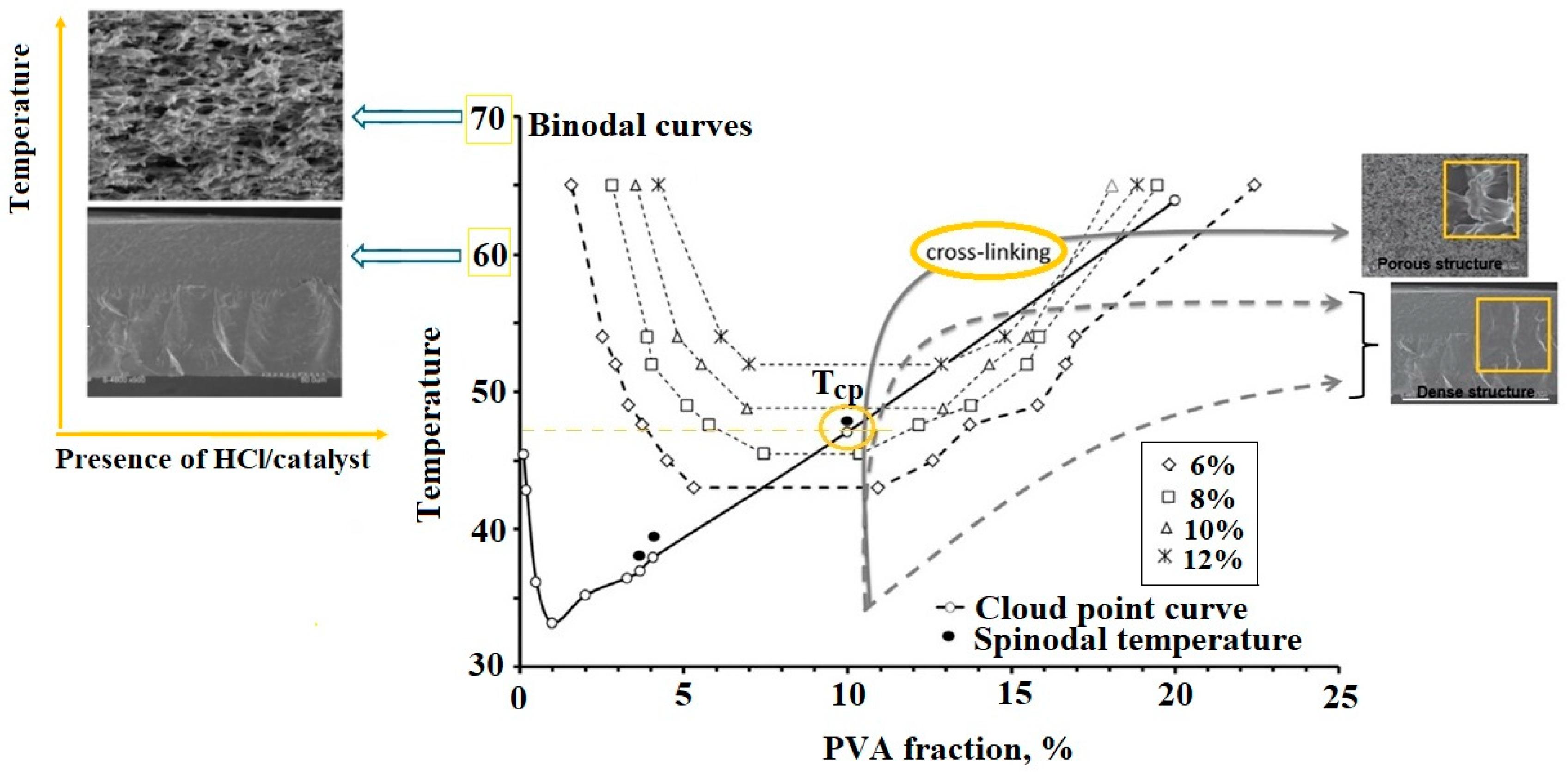
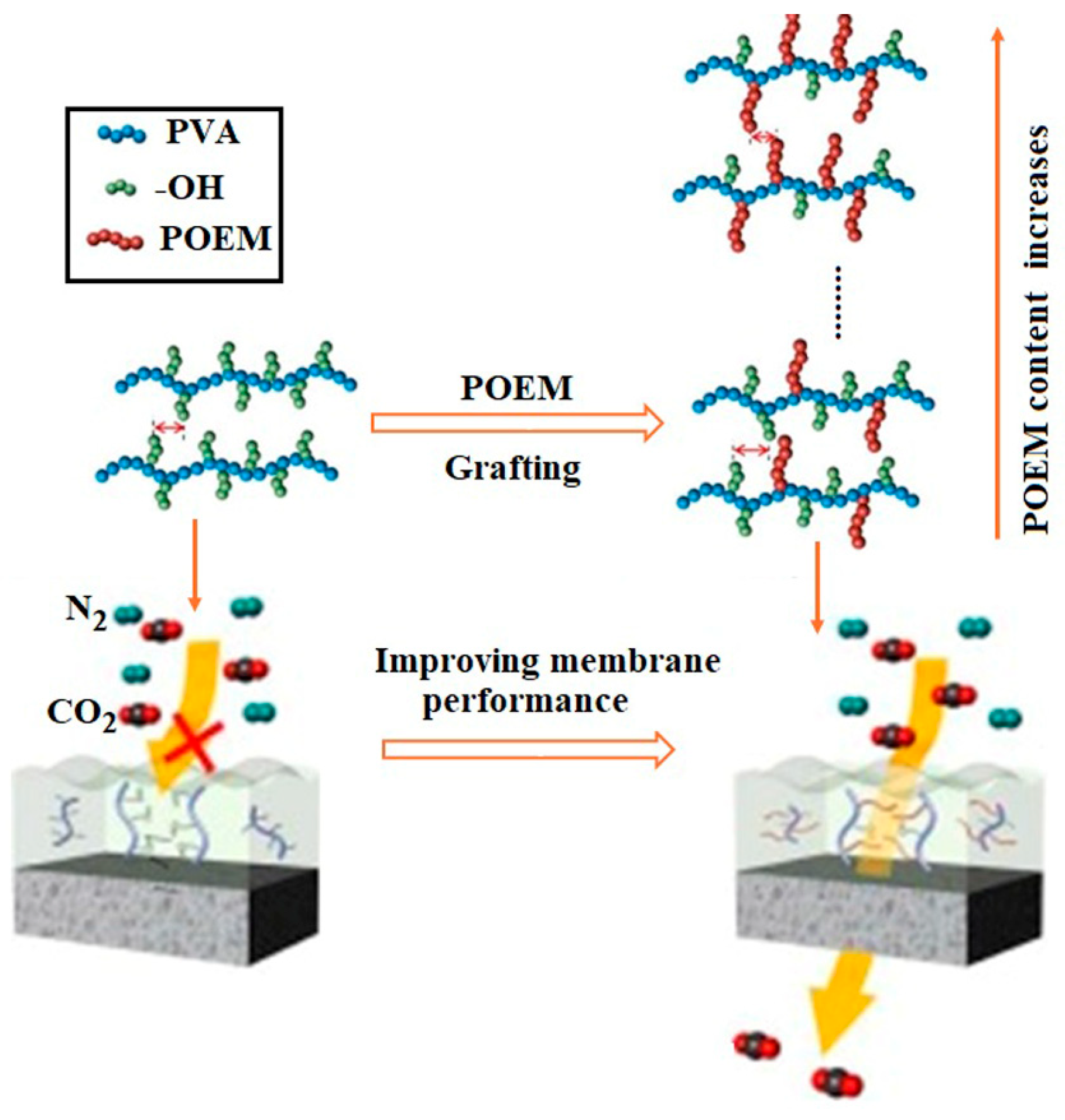
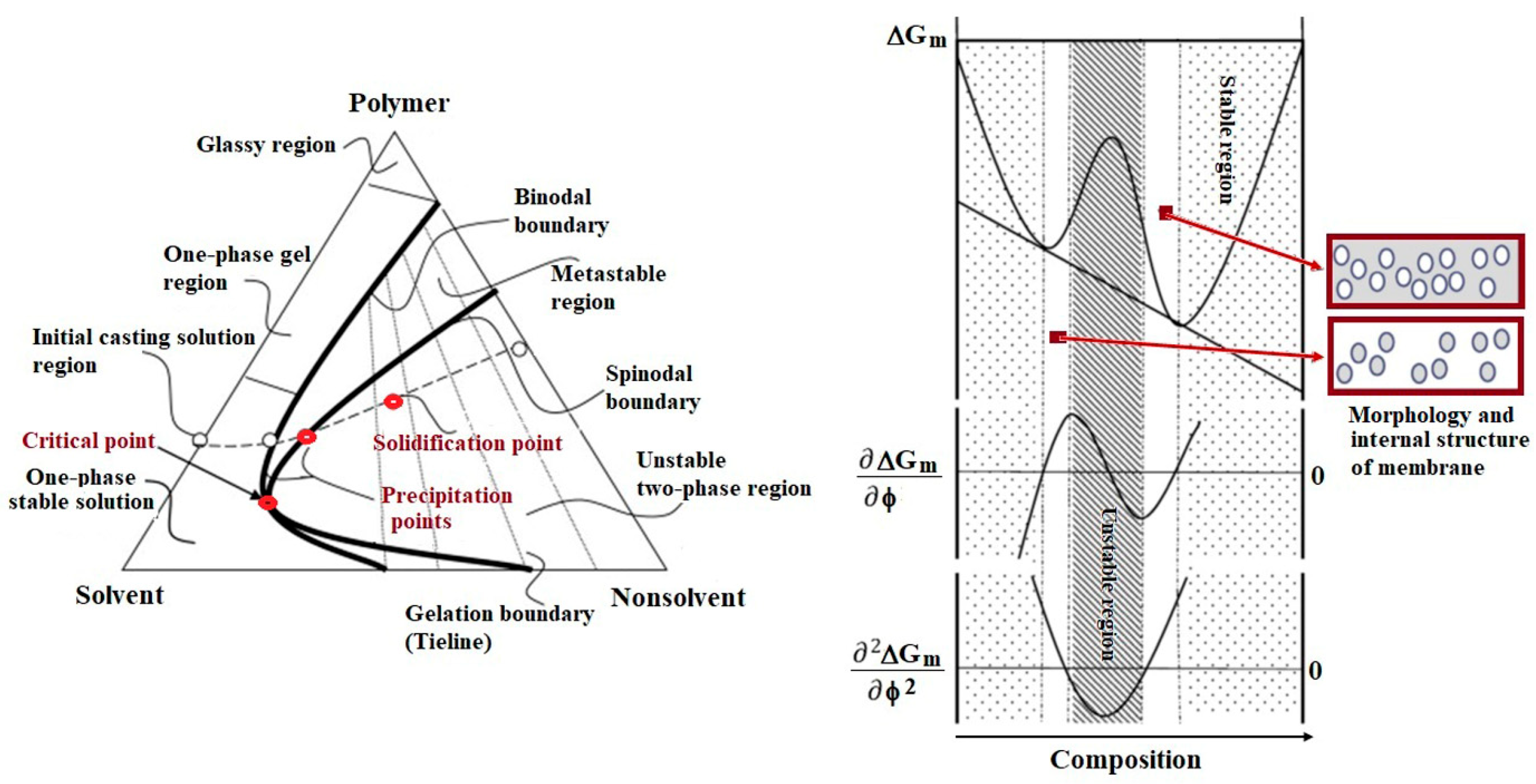

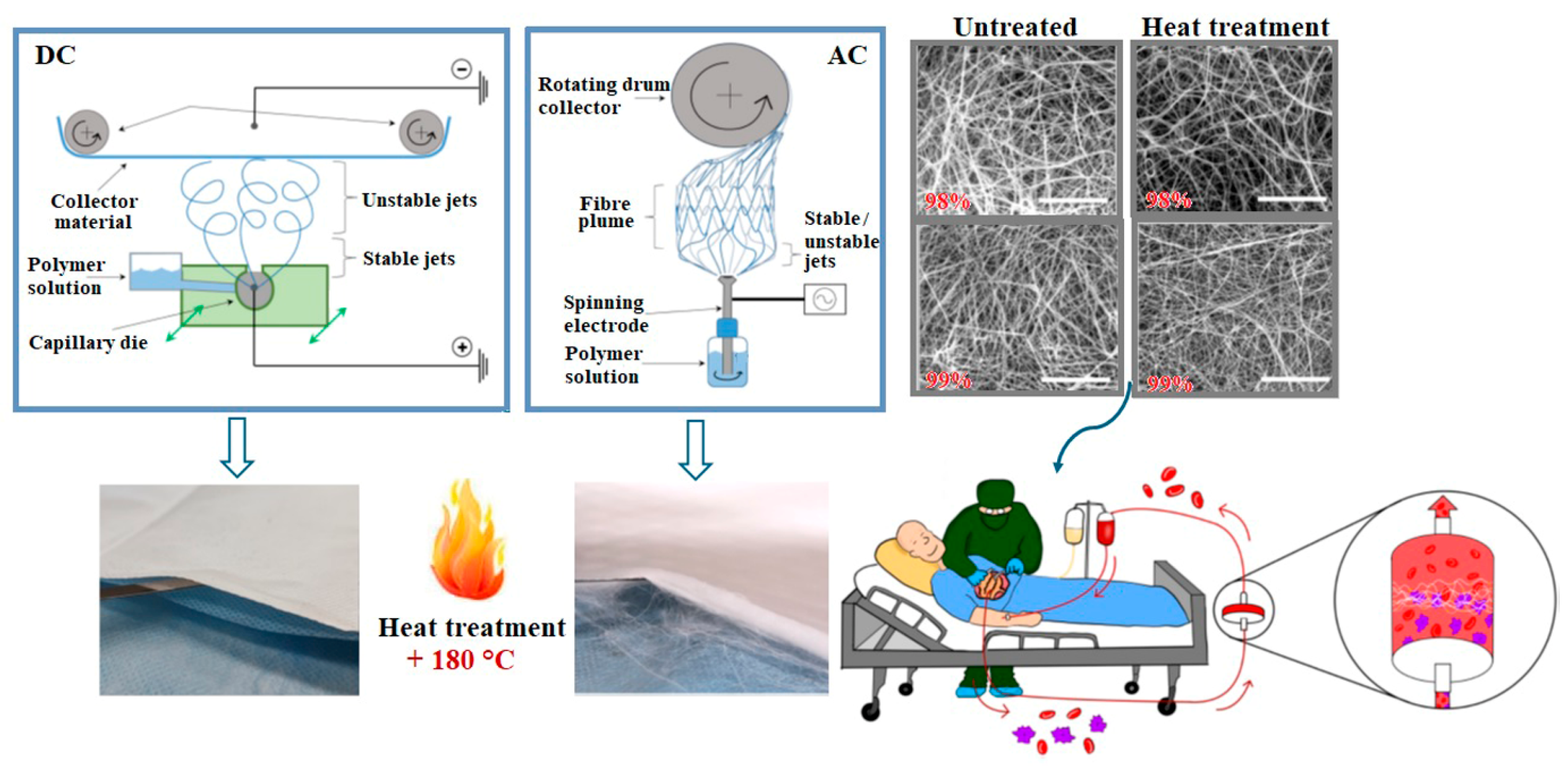
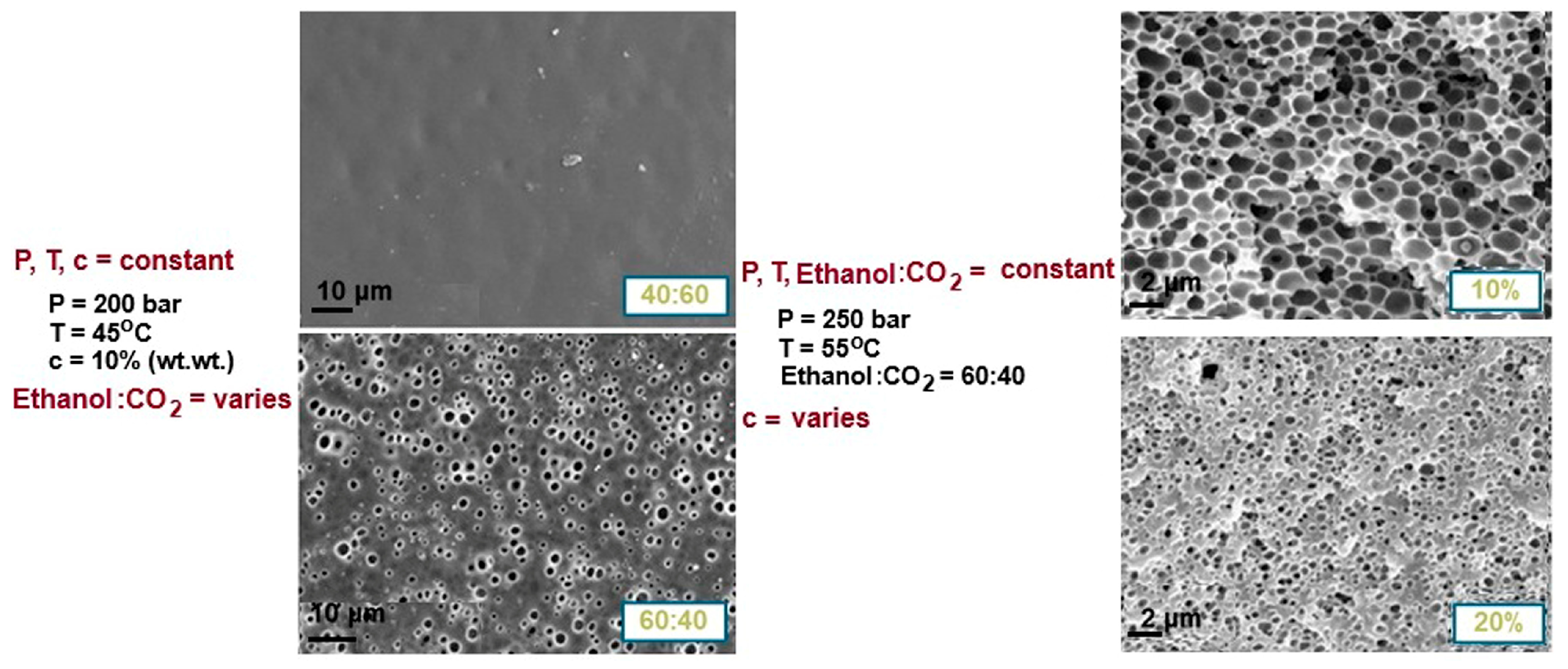
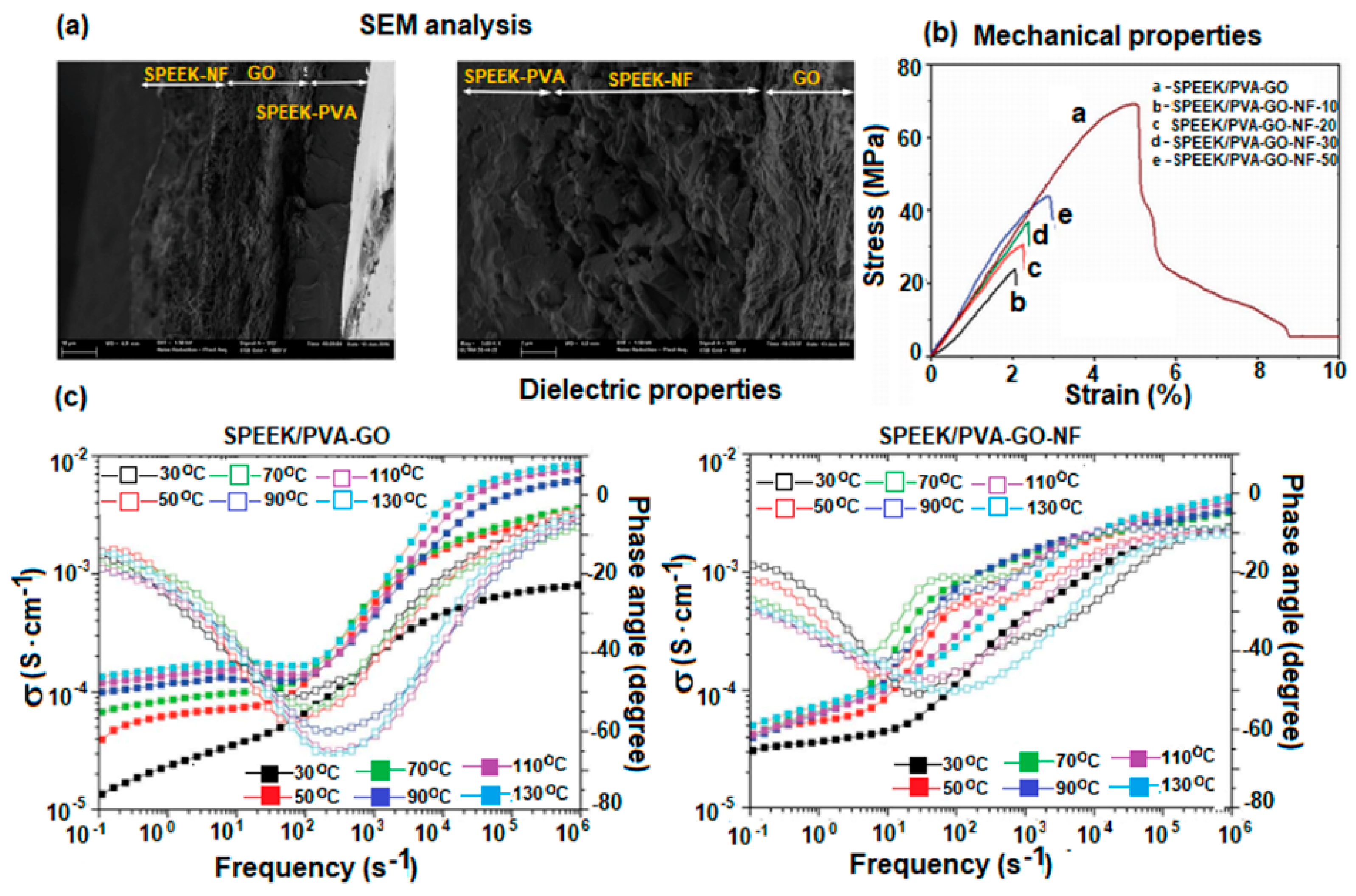
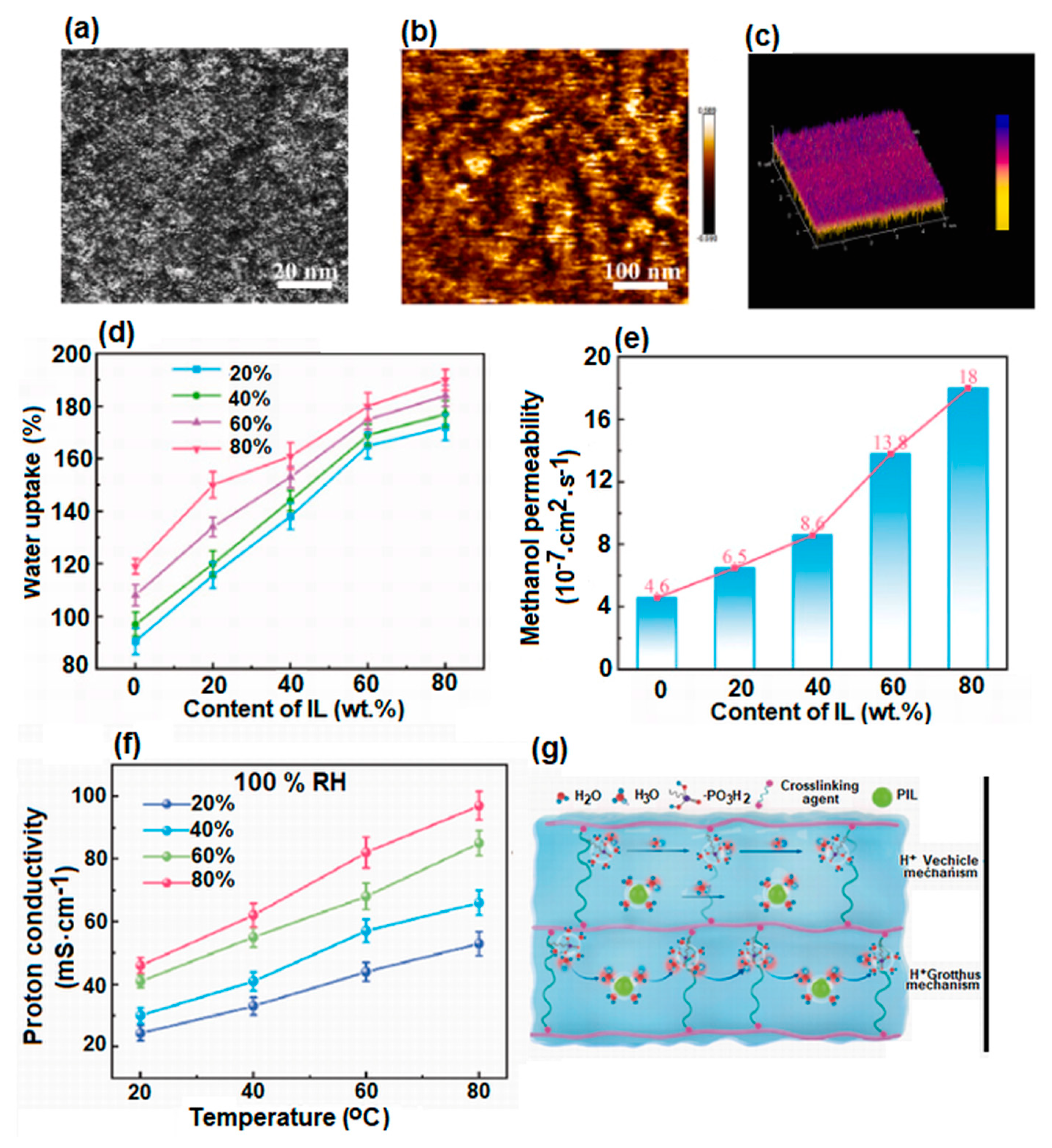
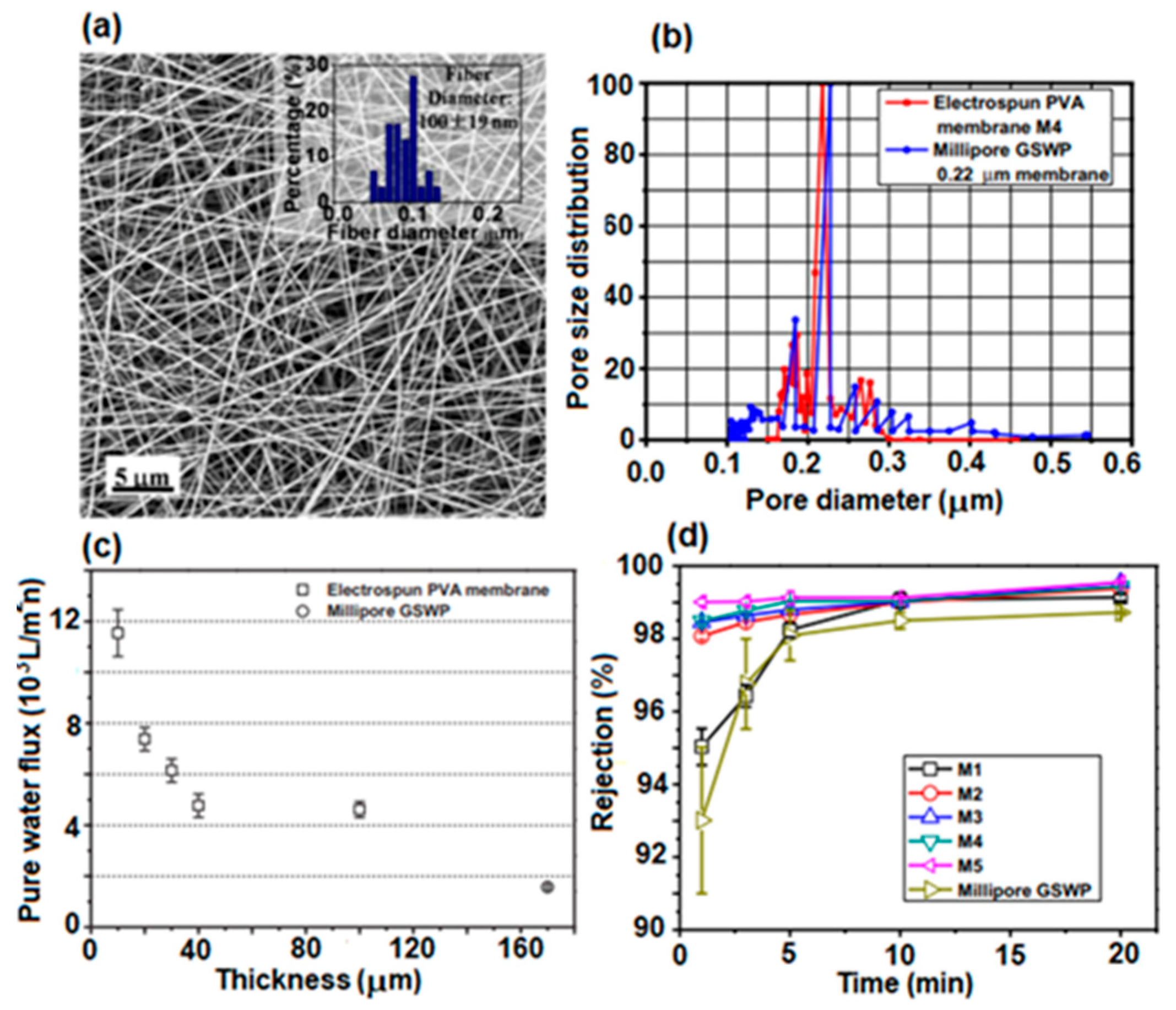

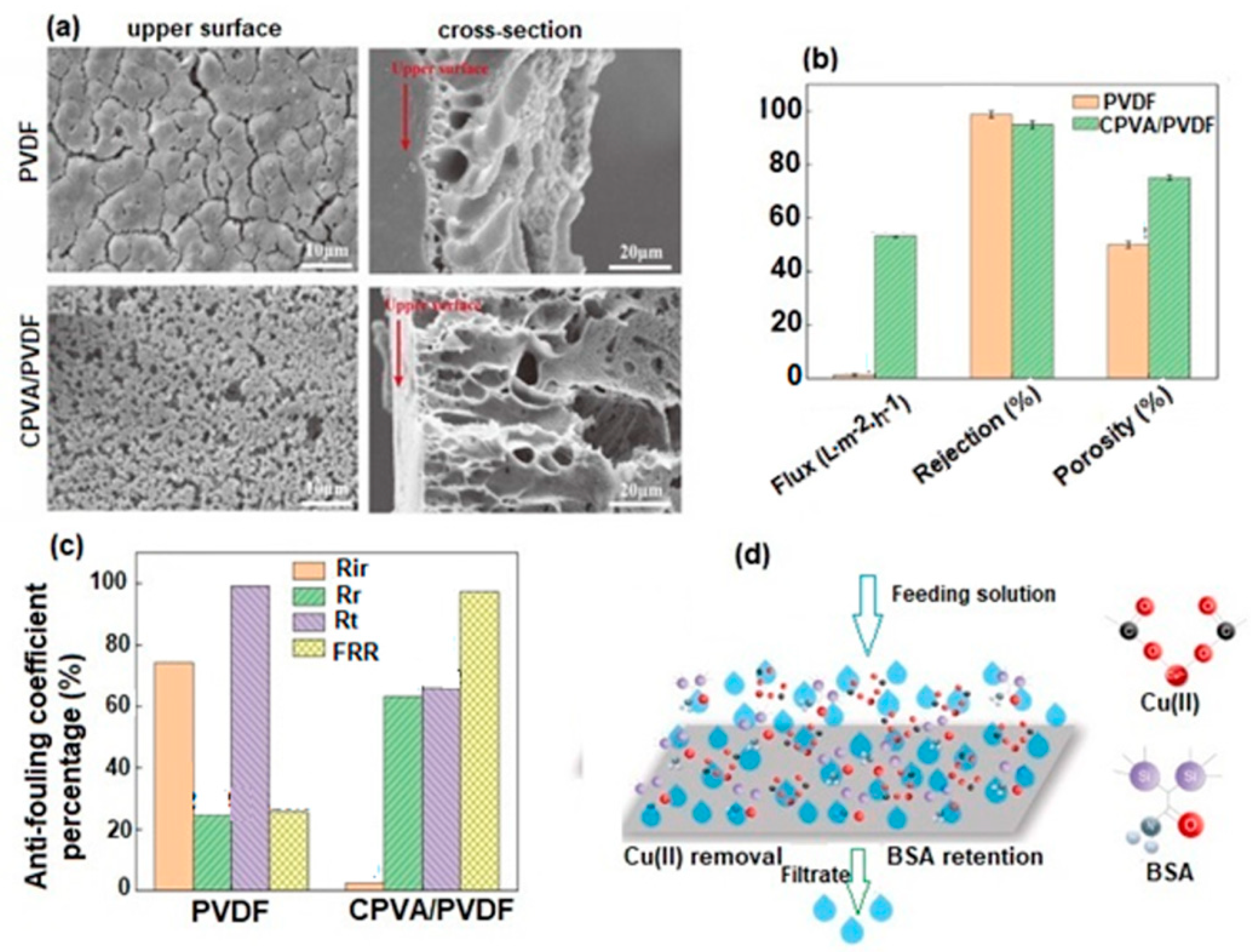
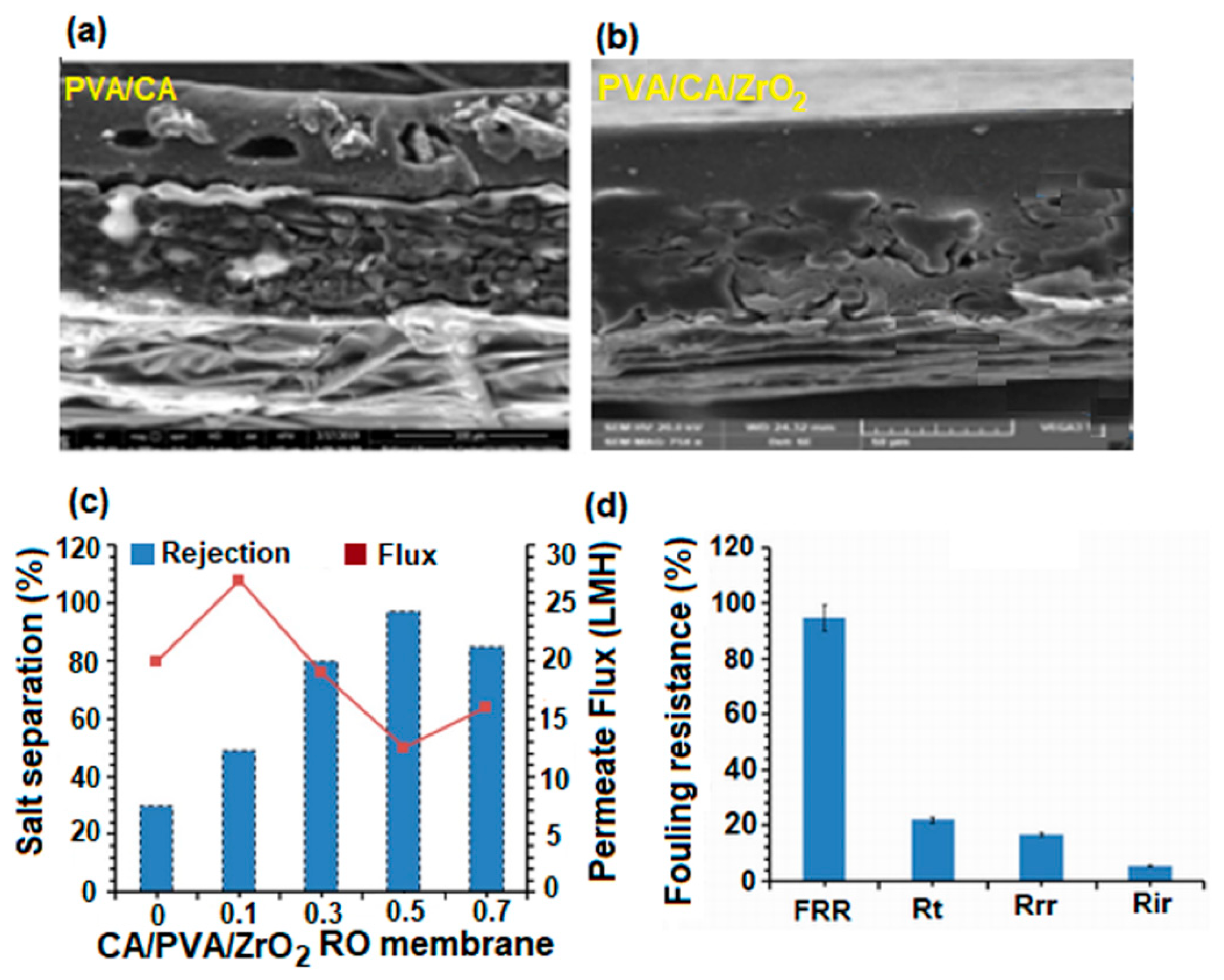
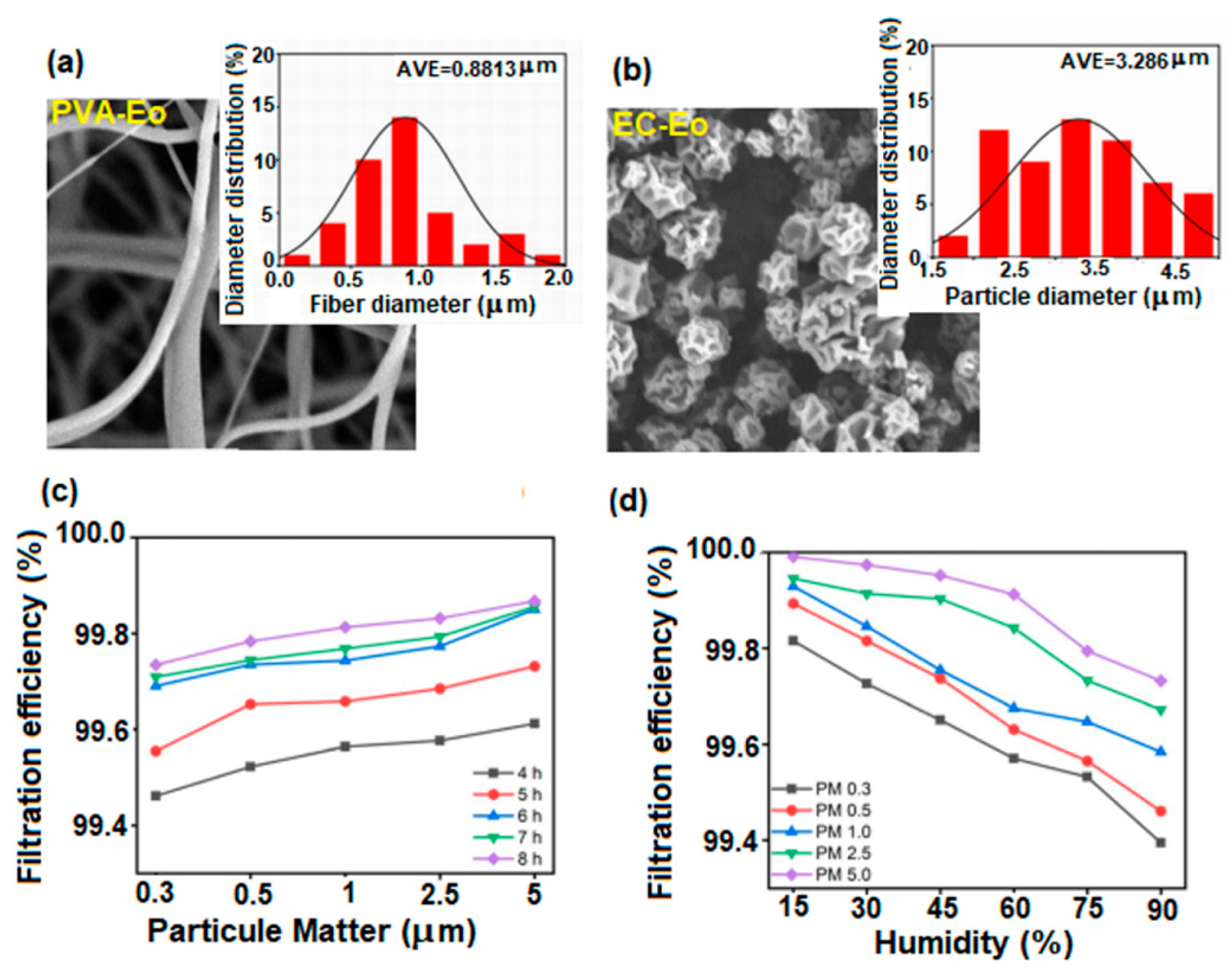
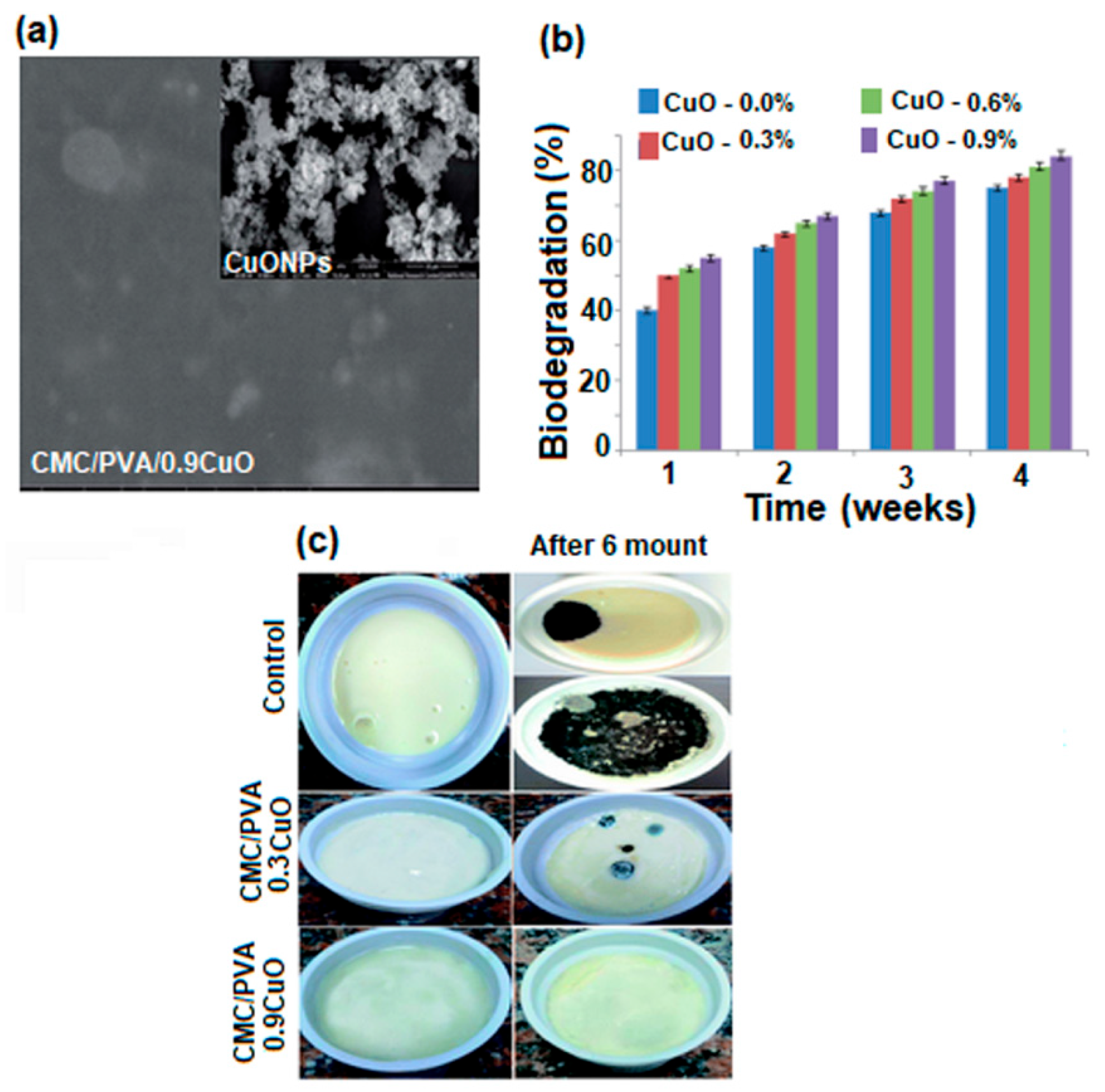




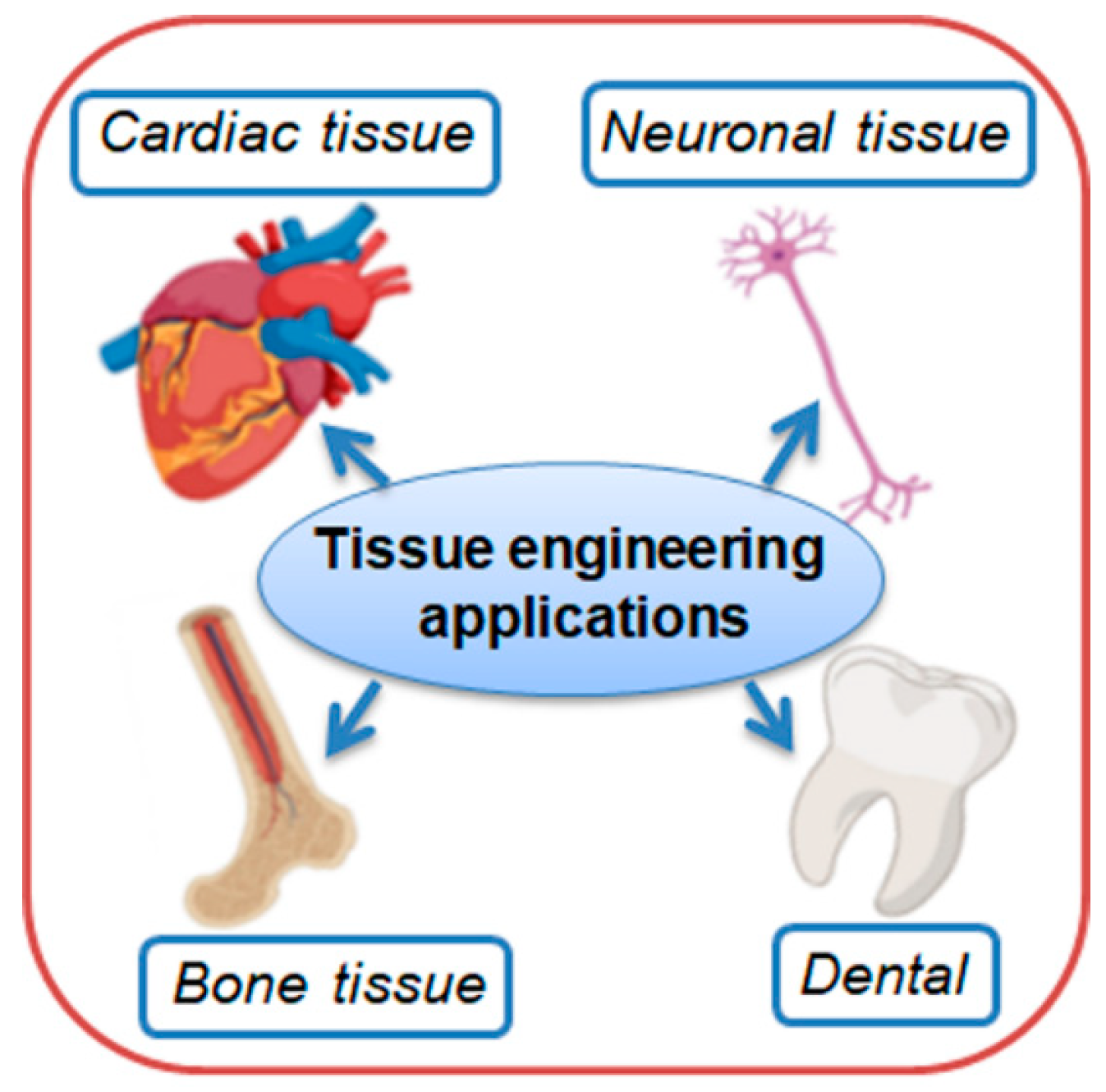


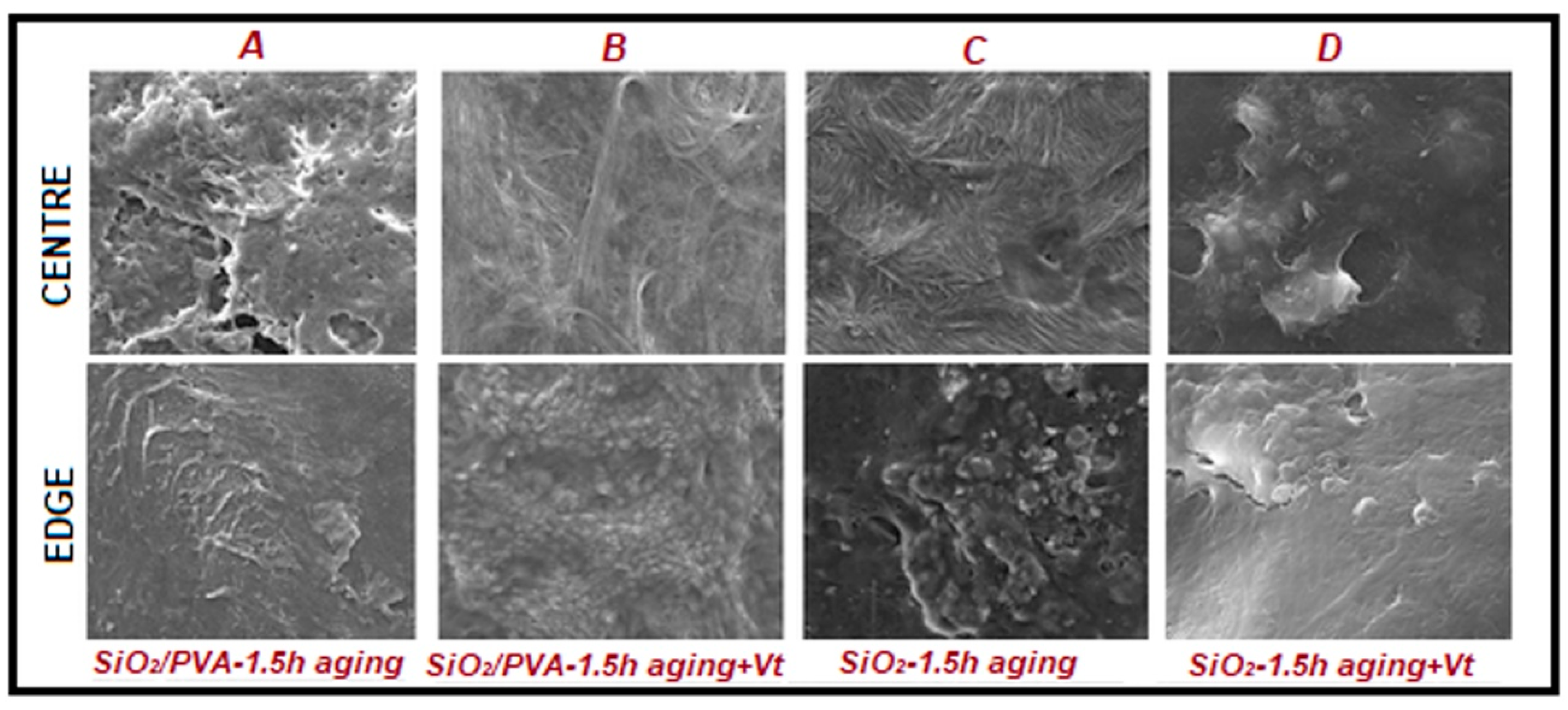

| Law/ Author | Equation | Phenomenological Parameters/ Involved Parameters | Membrane Mechanism |
|---|---|---|---|
| Darcy [57,58] | —average velocity | RO | |
| k—membrane permeability | |||
| µ—fluid viscosity | |||
| Hagen–Poiseuille [57,58] | ν—flow rate | MF, UF, NF | |
| —viscous resistance | |||
| ε—surface porosity | |||
| Carman–Kozeny [57] | K—Kozeny constant | MF, UF | |
| S0—specific surface of porous structure | |||
| Nernst–Planck [59,60] | Ji—solute flux | NF, RO | |
| Di—diffusivity of solute i | |||
| ci—solute concentration at membrane surface | |||
| x—mole fraction of solute | |||
| zi—valence of solute | |||
| F—Faraday’s constant | |||
| R, T—gas constant and temperature | |||
| Ψ—electric potential | |||
| Ki—distribution coefficient of solute | |||
| Jv—volume flux | |||
| Donnan [59,60] | Ci—feed concentration of solute | NF, RO | |
| ΨD—Donnan potential | |||
| Ψm—electrical potential of solution | |||
| ΨD—electrical potential of membrane | |||
| Spiegler, Kedem, Katchalsky [61,62,63,64] | σ—membrane reflection coefficient | NF, RO, UF | |
| Ehyd—hydration energy | |||
| Geraldes [65] | δω—ionic concentration | NF | |
| h—boundary layer thickness | |||
| l—length of filter channel | |||
| Re, Sc—Reynolds and Schmidt numbers: | |||
| 250 < Re < 1000 | |||
| 0.02 < Rep < 0.1 | |||
| 800 < Sc < 3200 | |||
| Shaalan [66] | J—solute flux | NF, UF | |
| J0—initial flux | |||
| t—time | |||
| I—ion strength | |||
| TOC—concentration | |||
| P—operating pressure | |||
| d—membrane cutoff |
| Applications | Key Characteristics | References |
|---|---|---|
| Drug delivery | Biocompatibility, controlled drug release, mucoadhesiveness, tunable mechanical properties, hydrophilic nature nanoparticle incorporation, pH-sensitive release | [218,221,228,229,230,231,232,233,234,235,236,237] |
| Wound dressing | High water absorption, oxygen permeability, antibacterial properties, mechanical strength, biodegradability | [238,239,240,241,242,243,244,245,246,247,248,249,250,251,252,253,254,255,256,257,258] |
| Tissue engineering and regenerative medicine | Cell adhesion, scaffold porosity, mechanical stability, biodegradability, tunable elasticity, bioactivity enhancement | [30,220,259,260,261,262,263,264,265,266,267,268,269,270,271,272,273,274] |
| Hemodialysis and artificial organs | Selective permeability, antifouling properties, hemocompatibility, mechanical durability, toxin adsorption | [83,275,276,277,278,279,280,281] |
| Other biomedical applications: periodontal treatment, ophthalmic, orthopedic, cancer therapy, immunotherapy, gene therapy, cosmetics | Adaptability, bioadhesion, sustained release, targeted therapy, soft tissue compatibility, non-toxicity | [282,283,284,285,286,287,288,289] |
Disclaimer/Publisher’s Note: The statements, opinions and data contained in all publications are solely those of the individual author(s) and contributor(s) and not of MDPI and/or the editor(s). MDPI and/or the editor(s) disclaim responsibility for any injury to people or property resulting from any ideas, methods, instructions or products referred to in the content. |
© 2025 by the authors. Licensee MDPI, Basel, Switzerland. This article is an open access article distributed under the terms and conditions of the Creative Commons Attribution (CC BY) license (https://creativecommons.org/licenses/by/4.0/).
Share and Cite
Filimon, A.; Dobos, A.M.; Onofrei, M.D.; Serbezeanu, D. Polyvinyl Alcohol-Based Membranes: A Review of Research Progress on Design and Predictive Modeling of Properties for Targeted Application. Polymers 2025, 17, 1016. https://doi.org/10.3390/polym17081016
Filimon A, Dobos AM, Onofrei MD, Serbezeanu D. Polyvinyl Alcohol-Based Membranes: A Review of Research Progress on Design and Predictive Modeling of Properties for Targeted Application. Polymers. 2025; 17(8):1016. https://doi.org/10.3390/polym17081016
Chicago/Turabian StyleFilimon, Anca, Adina Maria Dobos, Mihaela Dorina Onofrei, and Diana Serbezeanu. 2025. "Polyvinyl Alcohol-Based Membranes: A Review of Research Progress on Design and Predictive Modeling of Properties for Targeted Application" Polymers 17, no. 8: 1016. https://doi.org/10.3390/polym17081016
APA StyleFilimon, A., Dobos, A. M., Onofrei, M. D., & Serbezeanu, D. (2025). Polyvinyl Alcohol-Based Membranes: A Review of Research Progress on Design and Predictive Modeling of Properties for Targeted Application. Polymers, 17(8), 1016. https://doi.org/10.3390/polym17081016






